We’d just spent the morning exploring the quiet and well-preserved Herculaneum ruins before hopping onto a Circumvesuviana train to Sorrento, where we stayed for 2 nights before taking a ferry to Capri. If we’re being totally honest, we weren’t sure what to expect from Sorrento, but it turned out to be one of the most underrated places we’ve visited in Italy.
Usually we’re all about ticking off major attractions when visiting new places. Sorrento doesn’t have any, but that’s what made it such a surprise. Instead we found ourselves enjoying the travel basics – like slowly walking the attractive Via S. Cesareo or eating, drinking and people watching in Piazza Tasso. We loved our short time in Sorrento, and our only regret was not giving ourselves an extra day.
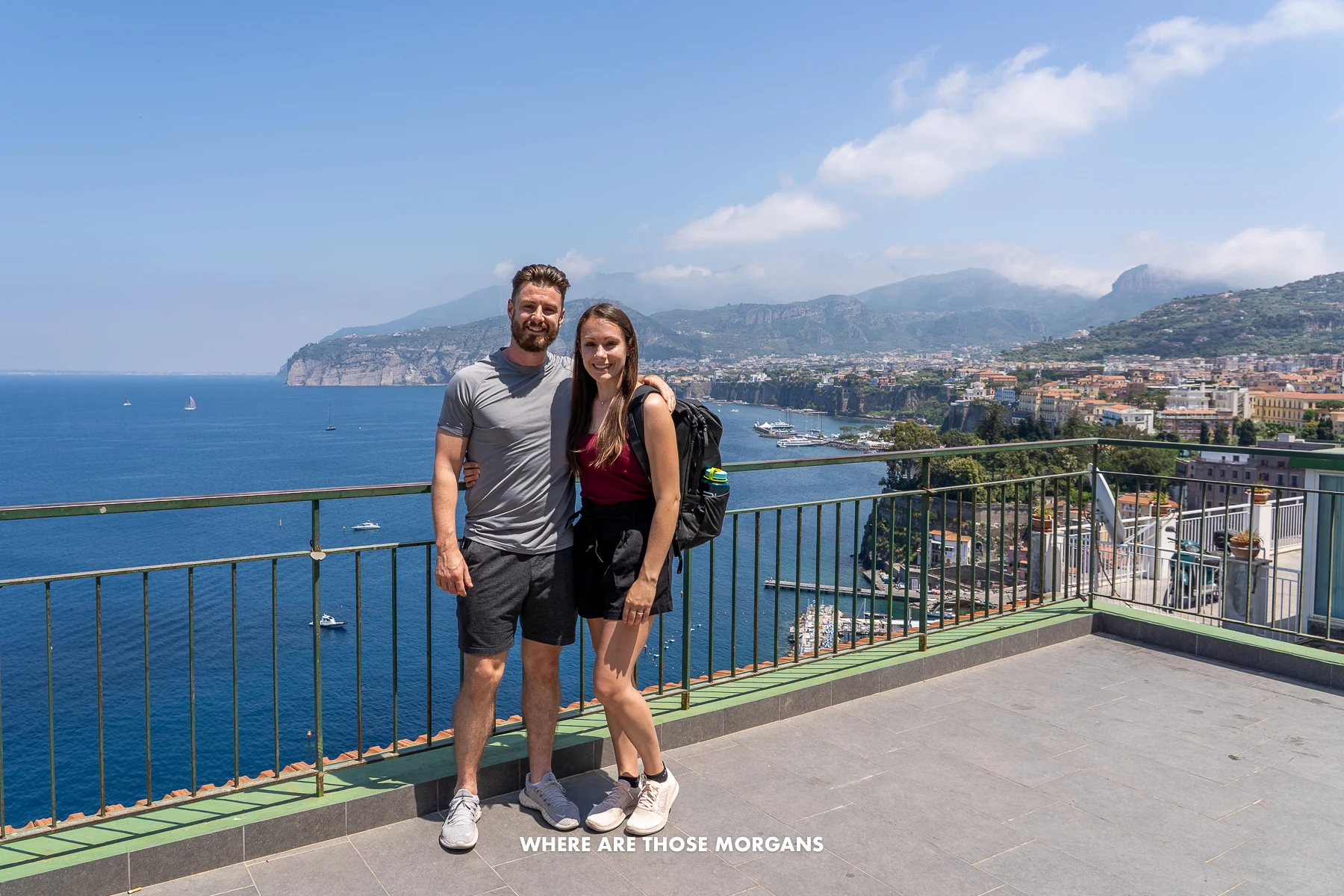 This is us with views over Sorrento behind
This is us with views over Sorrento behind
Hi, we’re Mark and Kristen Morgan. We left our scientific careers in 2018 to become travel writers and photographers, and since then our expert guides have helped millions of travel planners take better trips. Read more about us.
Why trust us with your Sorrento plans? We ticked off everything there is to do in Sorrento, and we visited all the major spots along the Gulf of Naples and Amalfi Coast, so we have perspective on what’s worth doing. As always, every photo in this guide is ours.
Walking through the picturesque Historic Center of Sorrento was easily our favorite thing to do, both by day and night. But we also visited churches, beaches and a hidden swimming spot in-between gorging ourselves on delicious food and wine. Our Amalfi Coast trip was in May with perfect weather for shorts, t-shirts and gelato that didn’t melt in seconds!
Based on the experiences we had, we’re going to show you the most unmissable things to do on a first visit to Sorrento, Italy. Okay, let’s begin!
Note: Our content is reader supported and contains affiliate links. If you make a purchase through one of these links, we may earn a small commission at no extra cost to you and it helps us keep this site running.
Walking The Cobbled Streets
We really liked the small size of Sorrento’s Historic Center because it made walking around the photogenic streets feel easy and achievable. Bigger places like Rome and Florence were much harder to get around, but Sorrento was tiny so it had more of an intimate feel.
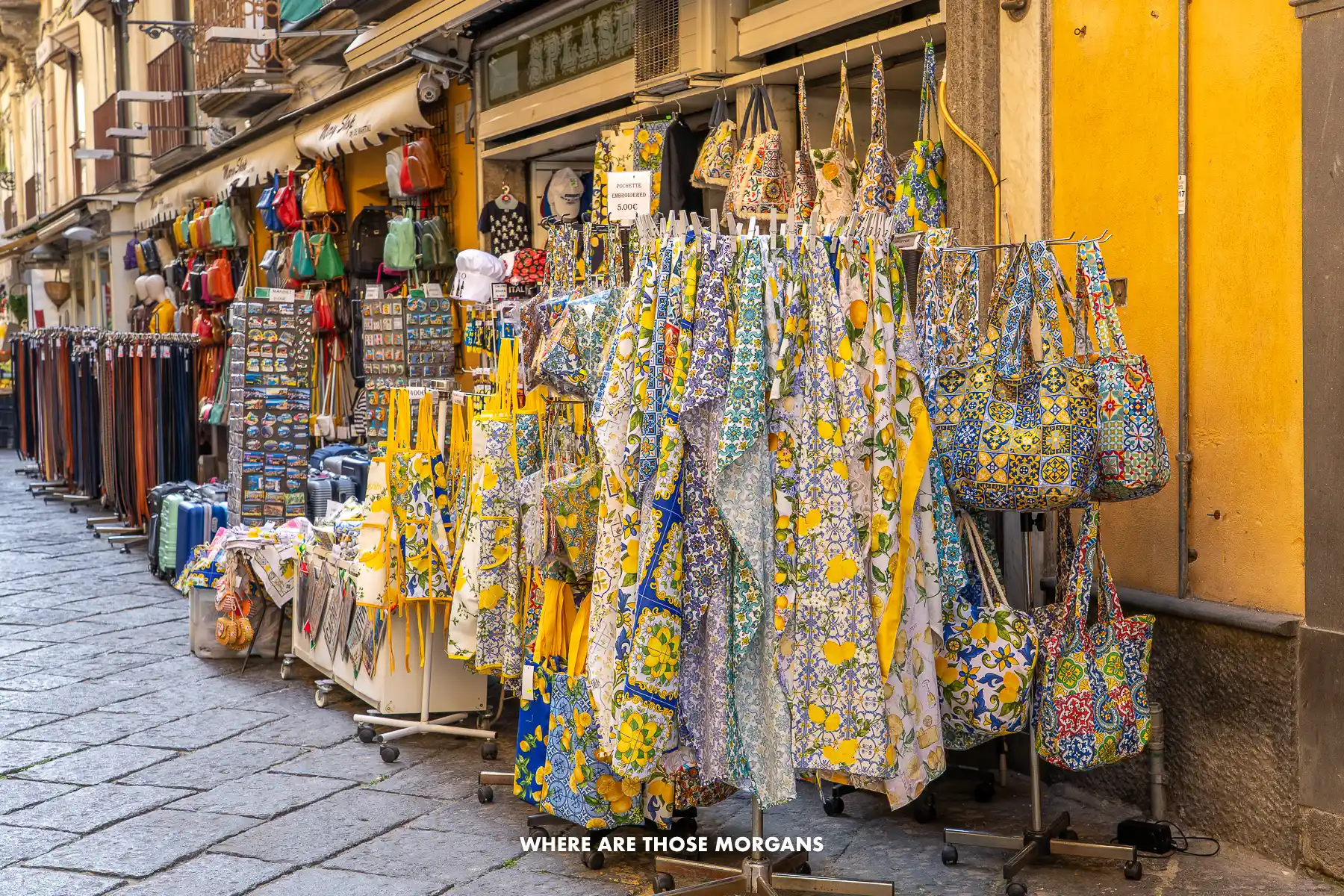 We loved the lemon inspired clothes and bags in Sorrento’s independent stores
We loved the lemon inspired clothes and bags in Sorrento’s independent stores
The narrow and cobbled Via S. Cesario (which turns into Via Fuoro) was our favorite street because it had tons of fantastic restaurants with outdoor seating and countless independent stores selling souvenirs, pottery, leather goods, clothes and jewelry.
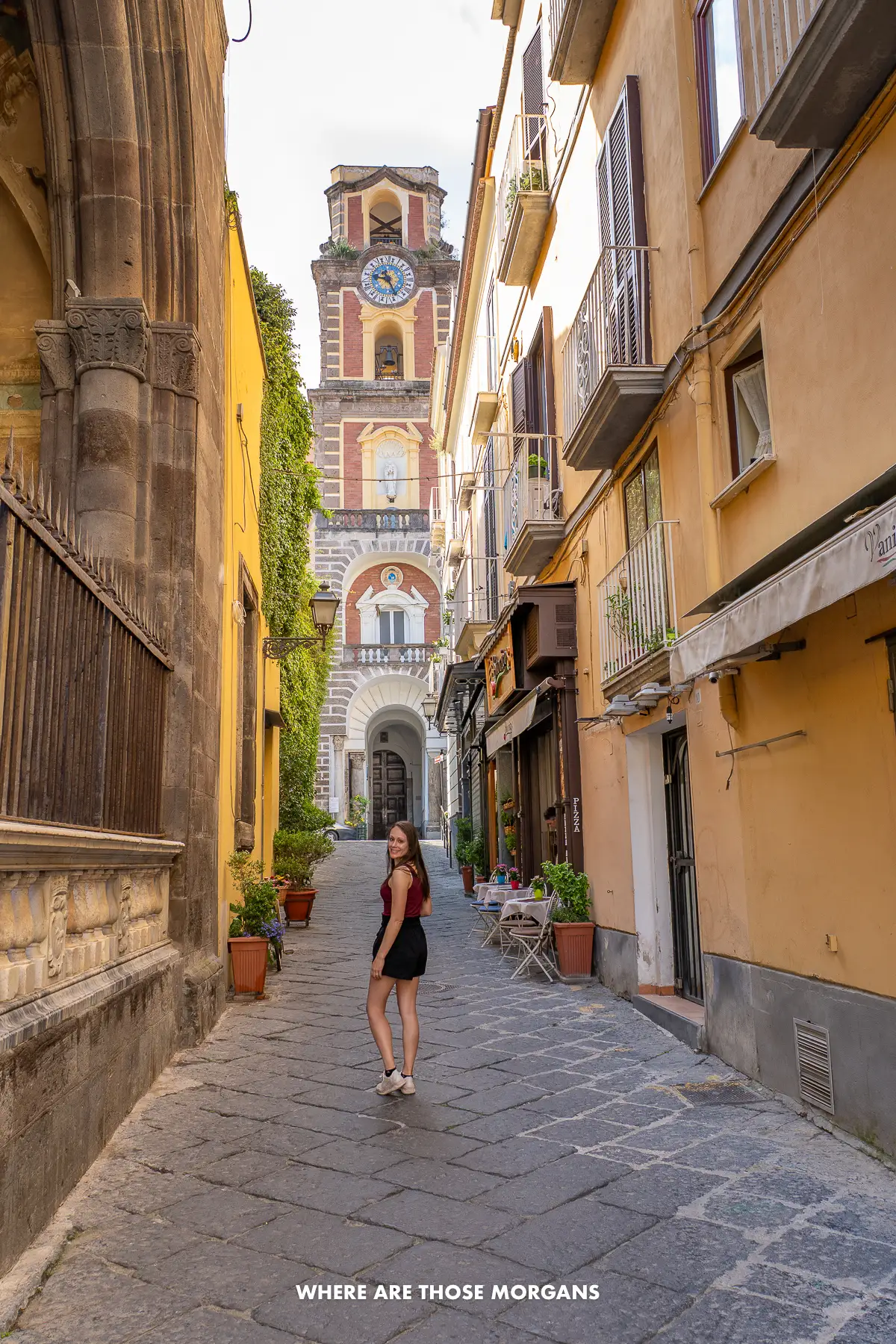 Here’s Kristen on Largo Padre Reginaldo Giuliani
Here’s Kristen on Largo Padre Reginaldo Giuliani 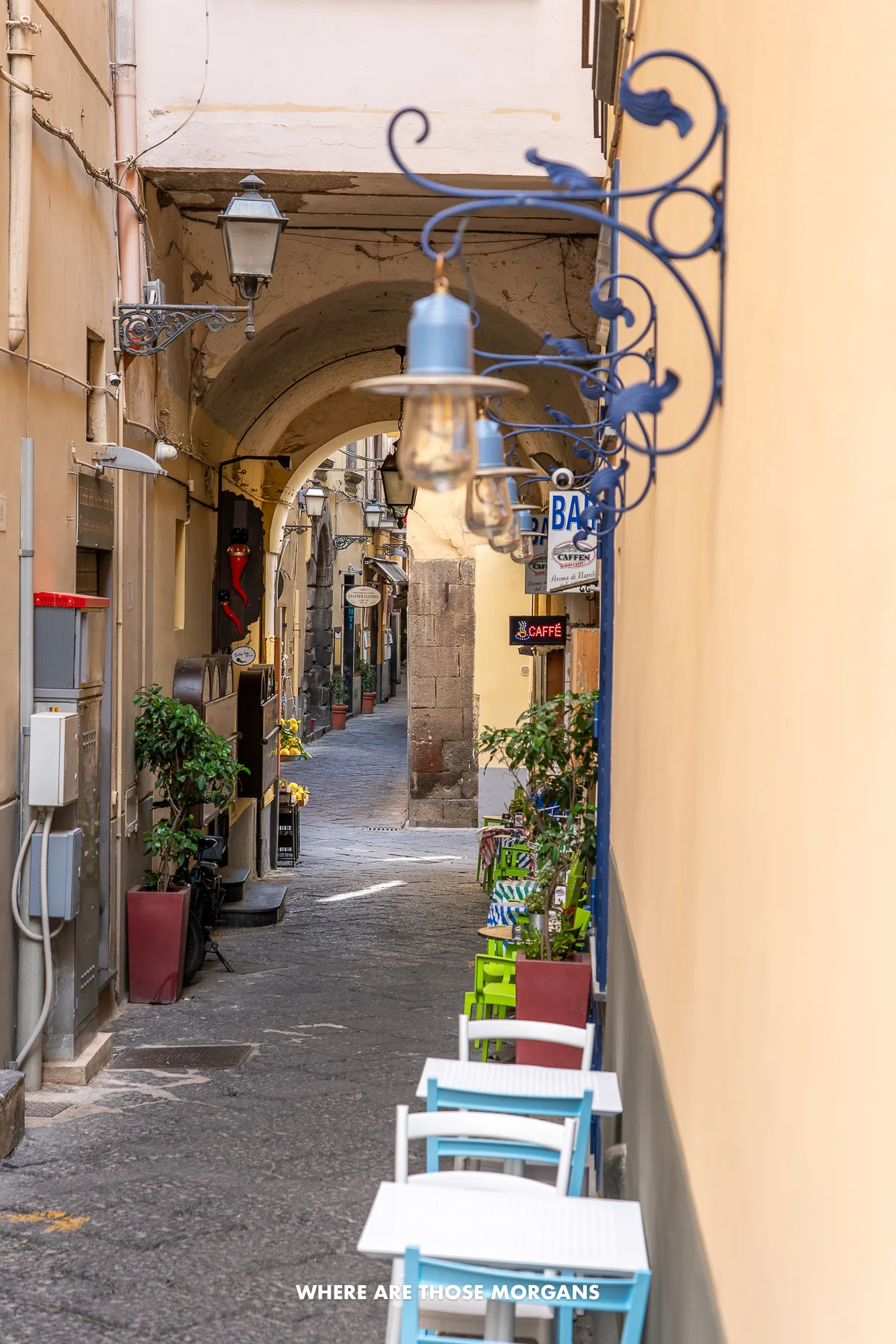 Getting off the main streets gave us people-free photos
Getting off the main streets gave us people-free photos
But Via S. Cesario was also the busiest street, so we made the effort to walk along every other street in the Historic Center – and we highly recommend you do the same if you’re not the sit-around-all-day type of traveler.
Getting off the main streets was the best way to find hidden gem spots to eat and drink, and to take people-free photos. Largo Padre Reginaldo Giuliani was a lovely cobbled street with tons of shops that we think is well worth exploring.
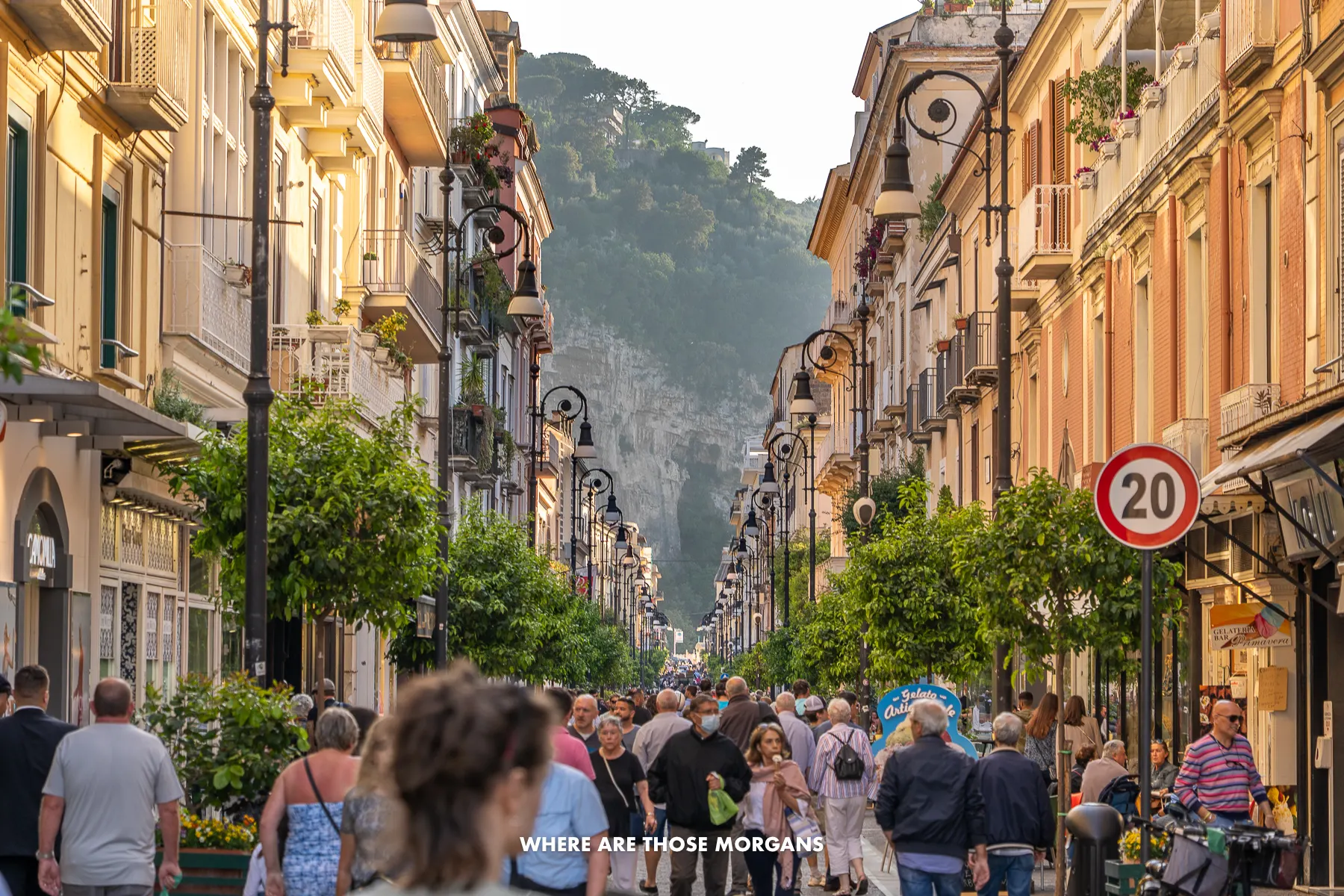 We used our telephoto lens to capture this awesome photo of people shopping along Corso Italia
We used our telephoto lens to capture this awesome photo of people shopping along Corso Italia
The long, straight and wide-open Corso Italia was a fantastic street to walk for shopping and cafes, plus it had lots of bars if you prefer something a bit more lively at night.
People Watching In Piazza Tasso
Okay, people watching is something we never put into our travel guides! But in Sorrento, we honestly felt like it was kind of the “in thing” to do.
And there’s no better place to people watch in Sorrento than the vast and expansive Piazza Tasso, where all the major roads through town meet.
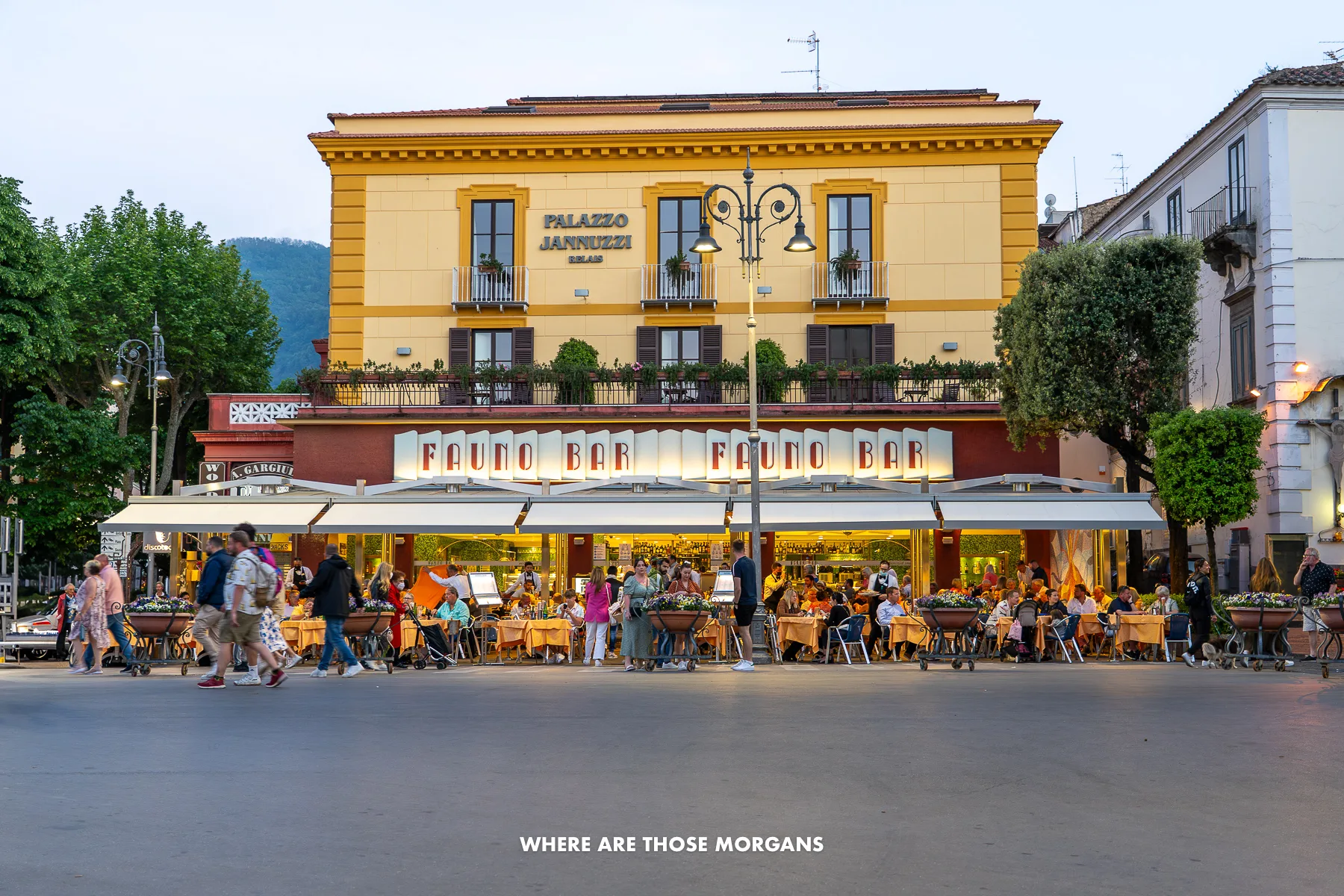 Fauno Bar was our favorite place to eat, drink and people watch in Piazza Tasso
Fauno Bar was our favorite place to eat, drink and people watch in Piazza Tasso
So we joined the throngs of tourists simply sat at outdoor tables drinking Aperol Spritz, eating snacks, soaking up the sun and escaping from the real world. And it was pure bliss.
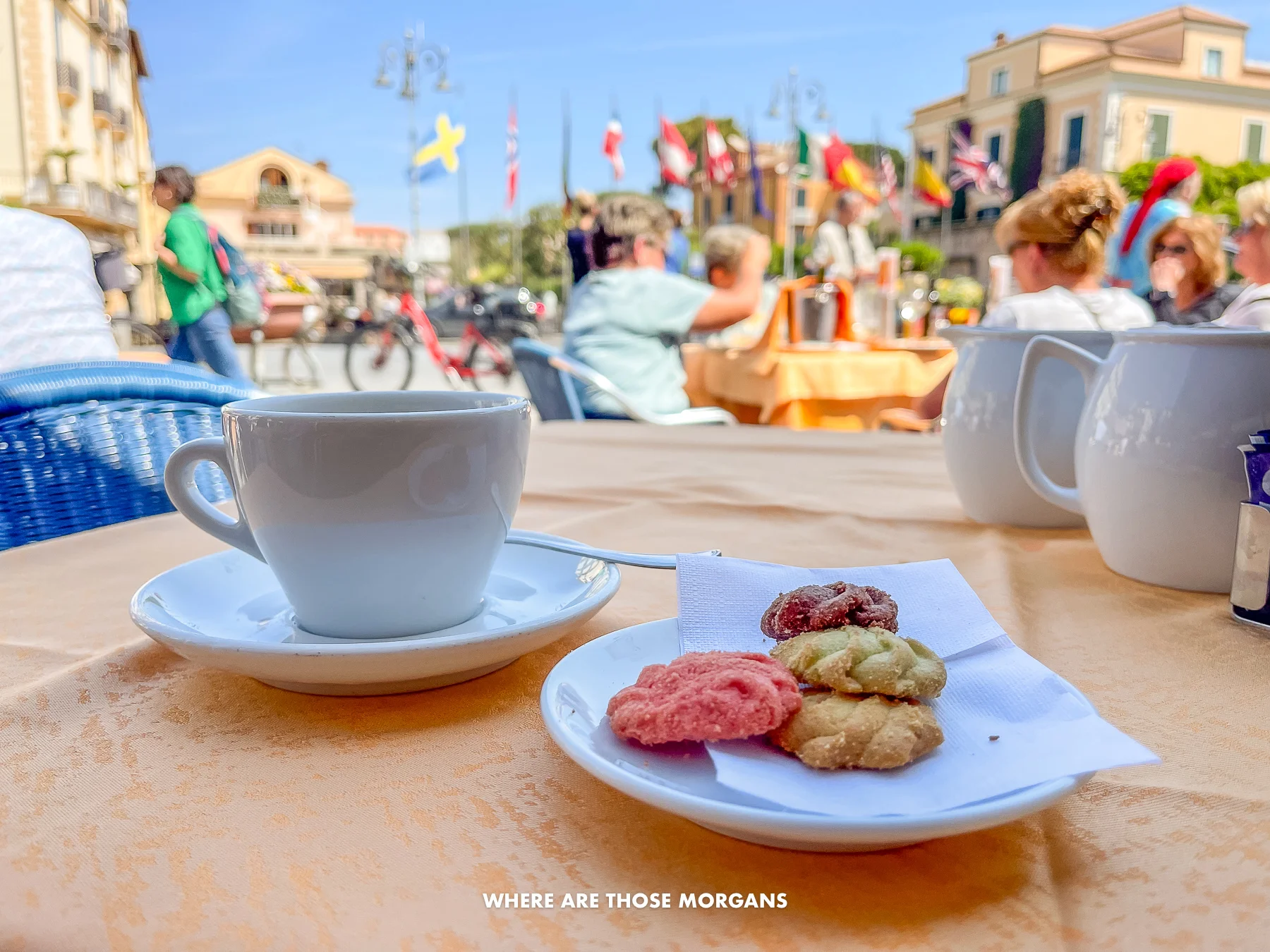 We also had coffee at Fauno Bar early in the morning before leaving Sorrento for Capri
We also had coffee at Fauno Bar early in the morning before leaving Sorrento for Capri
After looking at reviews online we decided to do our people watching in Fauno Bar and Restaurant, and it was the right choice.
But let us warn you, the food and drinks in Piazza Tasso are more expensive and not as good as other parts of Sorrento. We knew we were paying for the atmosphere and vibe.
Gorging On Local Food + Drinks
When there’s no major attractions sucking all the time from an itinerary, what else is there to do? For us, it’s gorge on local cuisine and drinks.
And in Sorrento, it’s all about rich tomato sauce flavors and of course the celebrated local liqueur called Limoncello.
 This was Mark’s gnocchi alla Sorrentina
This was Mark’s gnocchi alla Sorrentina
We both enjoyed tasting the regional Gnocchi alla Sorrentina at Ristorante L’Abate in Piazza Sant’Antonino, and we had a wonderful healthy lunch at Enjoy The Little Things Bistrot.
 This was Mark’s Cannelloni alla Sorrentina at the excellent Fuoro
This was Mark’s Cannelloni alla Sorrentina at the excellent Fuoro
Mark also sampled Cannelloni alla Sorrentina and Kristen tried Spaghetti alla Nerano at Fuoro – the meal sizes were small but they were delicious and it was a lovely place to eat on Via S. Cesario.
And right next door, we devoured gelatos from Antica Gelateria Sorrentina. Perfect!
 This was one of the pizzas we got from Frankie’s
This was one of the pizzas we got from Frankie’s
Going to Italy and not eating pizza should be considered a crime in our book. We rarely go a day without eating pizza for either lunch or dinner when we visit Italy because you really can’t get it like they do it anywhere else in the world – and trust us, we’ve tried!
We ate at Frankie’s Pizza Bar and Ristorante Tasso. Both were excellent, but next time we’d try Capri Blu and Il Leone.
 These were two of the many Limoncello Spritz cocktails we enjoyed
These were two of the many Limoncello Spritz cocktails we enjoyed
Then came the drinks. Aperol Spritz is the classic Italian cocktail and we found them so refreshing on those blazing hot days.
But in Sorrento where the lemons are grown locally, you absolutely must try Limoncello – we honestly couldn’t get enough of the delightfully chilled lemon liqueur.
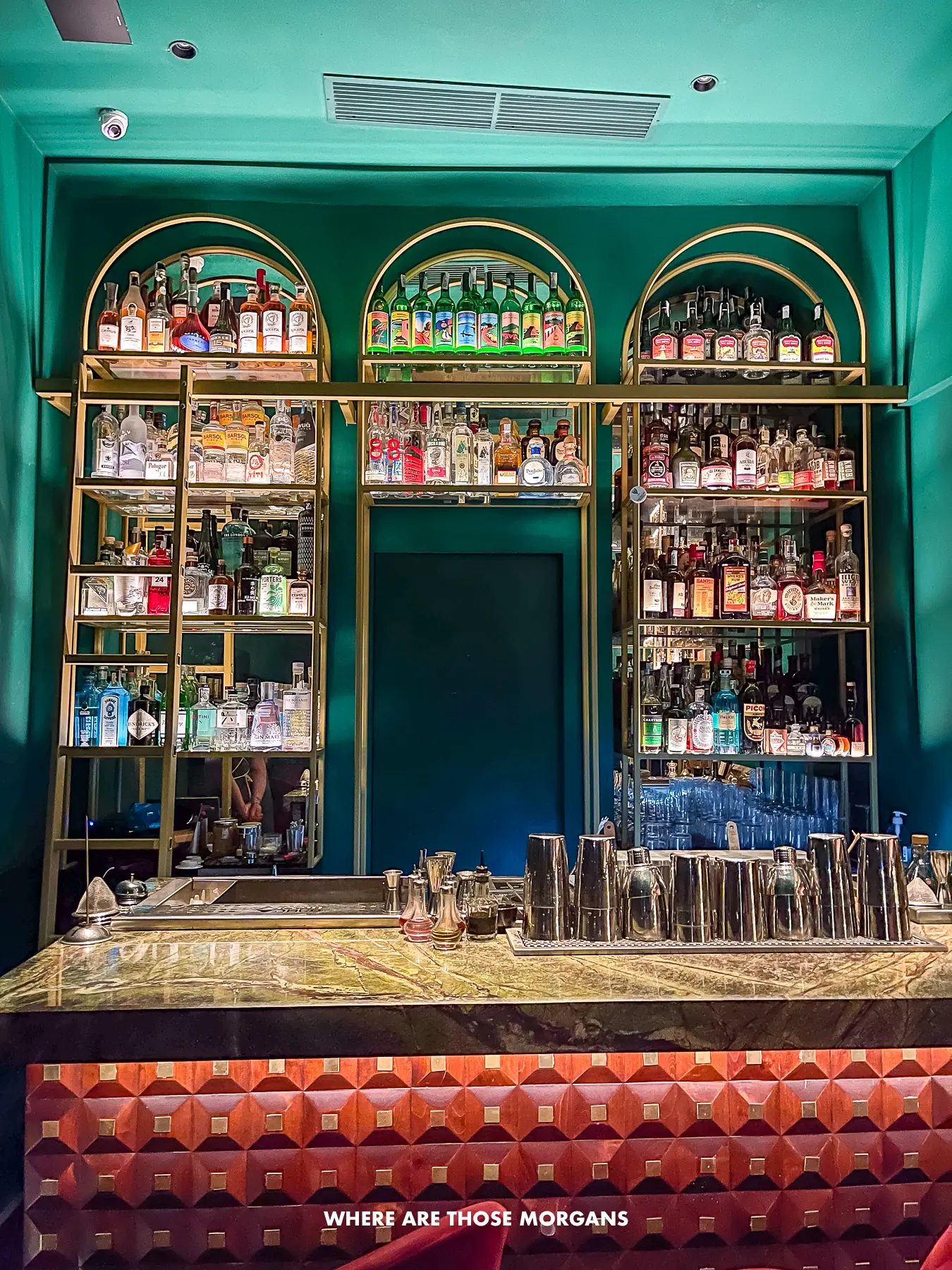 We had a quick Amaretto Sour in SHUB
We had a quick Amaretto Sour in SHUB  This was Kristen sampling Limoncello and lemon flavored nuts
This was Kristen sampling Limoncello and lemon flavored nuts
We’re also partial to an Amaretto Sour and highly recommend giving one a try when you’re in Sorrento. If you like the sound of a classy cocktail in a not-so-hidden speakeasy, go to SHUB on Via Santa Maria della Pieta. We were the only people inside the secret cocktail bar at 10:00pm, and looking back we think it’s because we were too early!
But Limoncello is the big one and you’ll find tons of shops selling it by the bottle. Our advice is to find a place offering free samples so you can try before you buy. And here’s more advice – make sure you leave enough room in your suitcase to take a bottle home!
Tip: Sorrento has the best food tours on the Amalfi Coast, so if you want to spend money on a foodie tour this is the place to do it. We’d love to try this top rated farm and food experience or this top rated pizza class – both include limoncello and wine tasting.
Relaxing On A Beach
We’re going to be blunt – Sorrento’s beaches aren’t anything to shout about. In fact, we found them to be massively underwhelming so don’t plan your trip around sitting on golden sand because you’re not going to get it here.
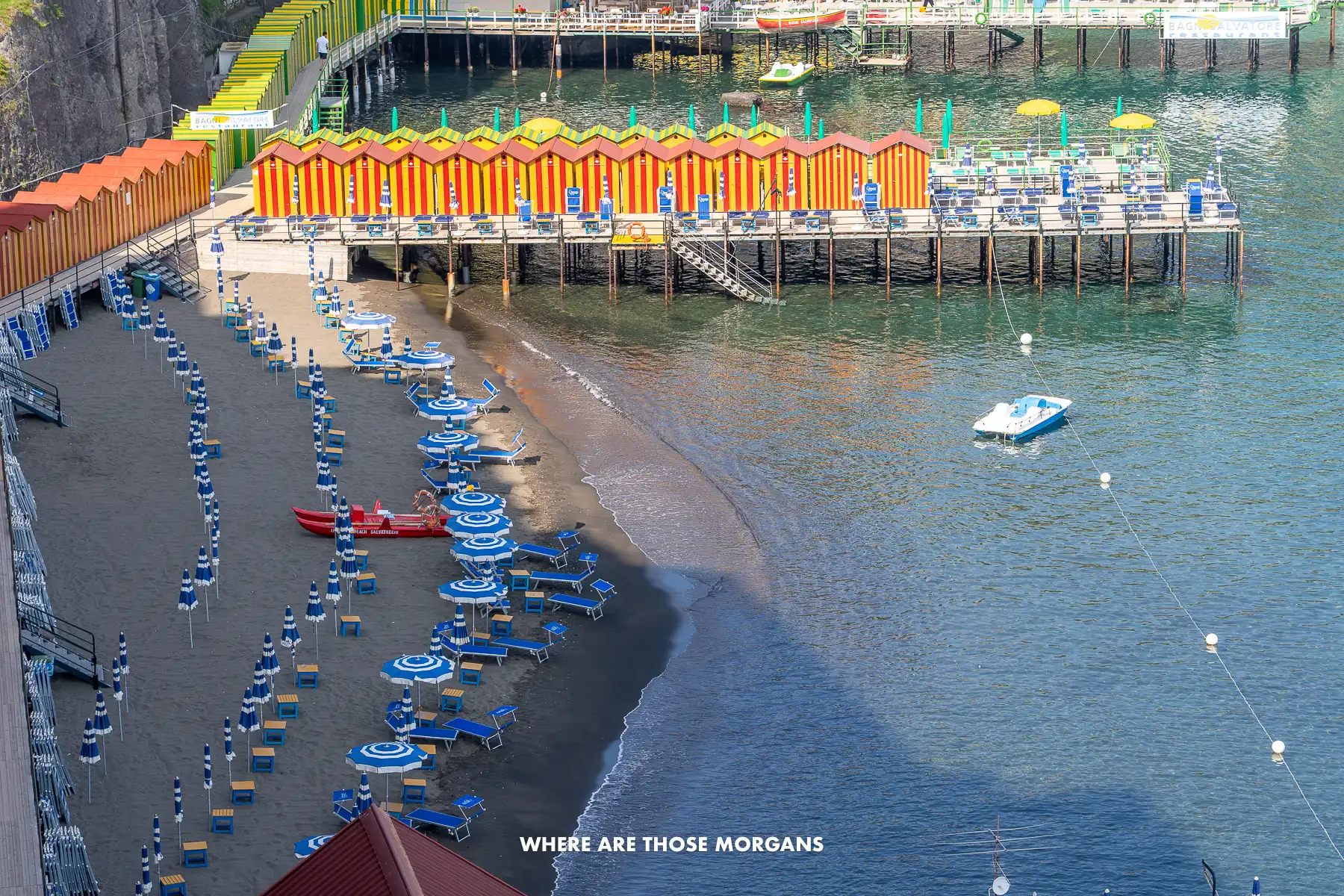 We took this photo of Peter’s Beach which actually has a bit of pebbly sand
We took this photo of Peter’s Beach which actually has a bit of pebbly sand
We took an early morning walk down a stairway from Villa Comunale (which we cover later) to check out the public beach, and it was little more than a tiny patch of pebbles. It certainly didn’t scream “come and spend a day here”.
But if you are intending to sunbathe, there is some good news. We walked to several artificial rocky platforms jutting out into the bay that were covered with sun loungers and had bars for a bit of daytime refreshment.
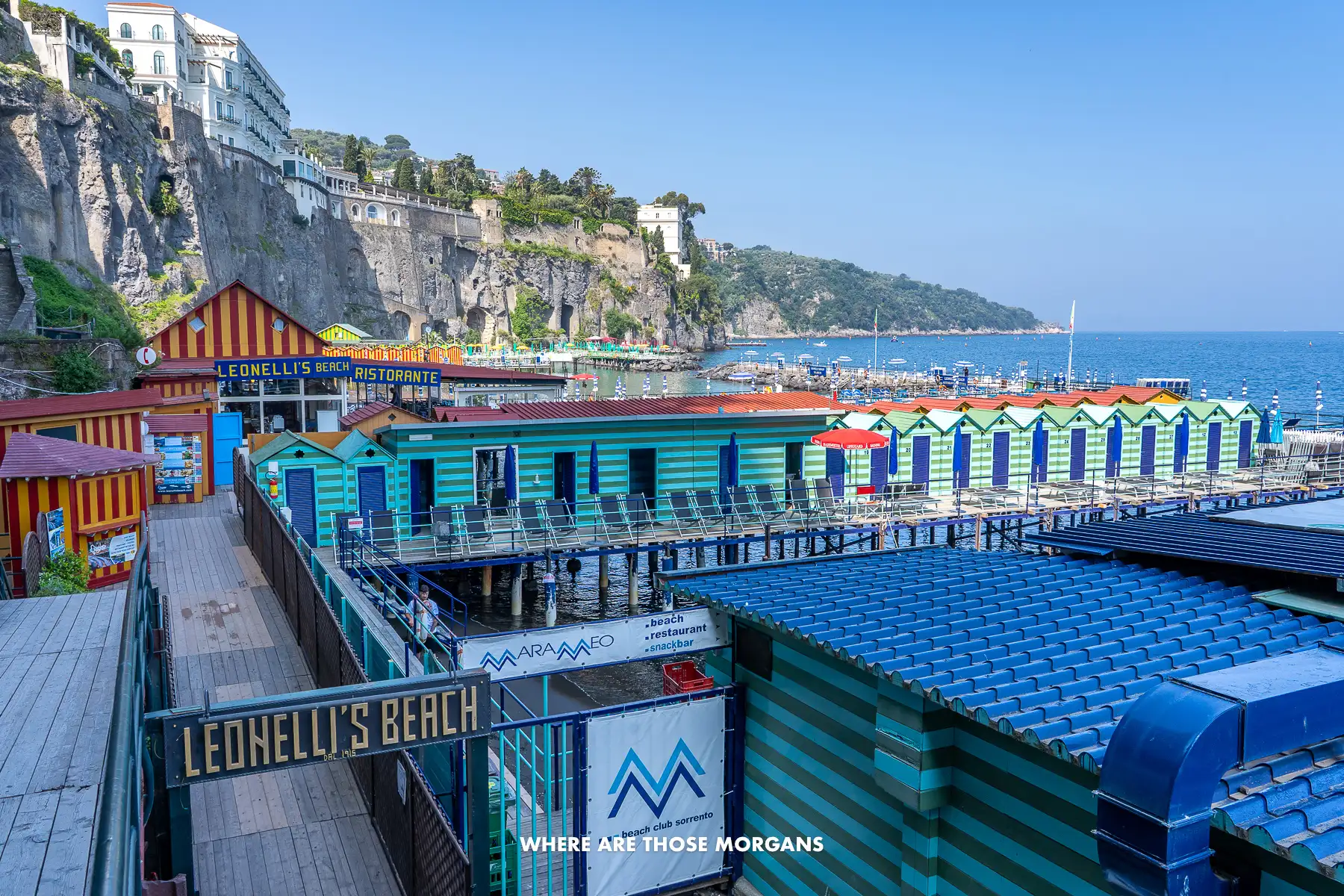 Leonelli’s Beach was more of a wooden pier setup with ladders into the sea
Leonelli’s Beach was more of a wooden pier setup with ladders into the sea
We took a look at Peter’s Beach and Leonelli’s Beach which were pretty much identical, except Peter’s had sand and Leonelli’s had wooden platforms with ladders into the water. Then we also looked at Bagni Salvatore which looked a bit nicer and more secluded.
All three are paid beach clubs, so they have overpriced restaurants and drinks, plus you’ll pay to enter and hire a sun lounger. You’re looking at a minimum of €15 per person for entry and a sun lounger. Don’t forget a towel otherwise it’s even more expensive!
Tip: We considered visiting Spa Ulysse for more relaxation but it had mixed reviews so we skipped it.
Visiting Marina Grande
Those beach areas we just mentioned aren’t great but here’s a top tip from our trip – we found a much better public beach on the other side of town in Marina Grande called Spiaggia di Sorrento.
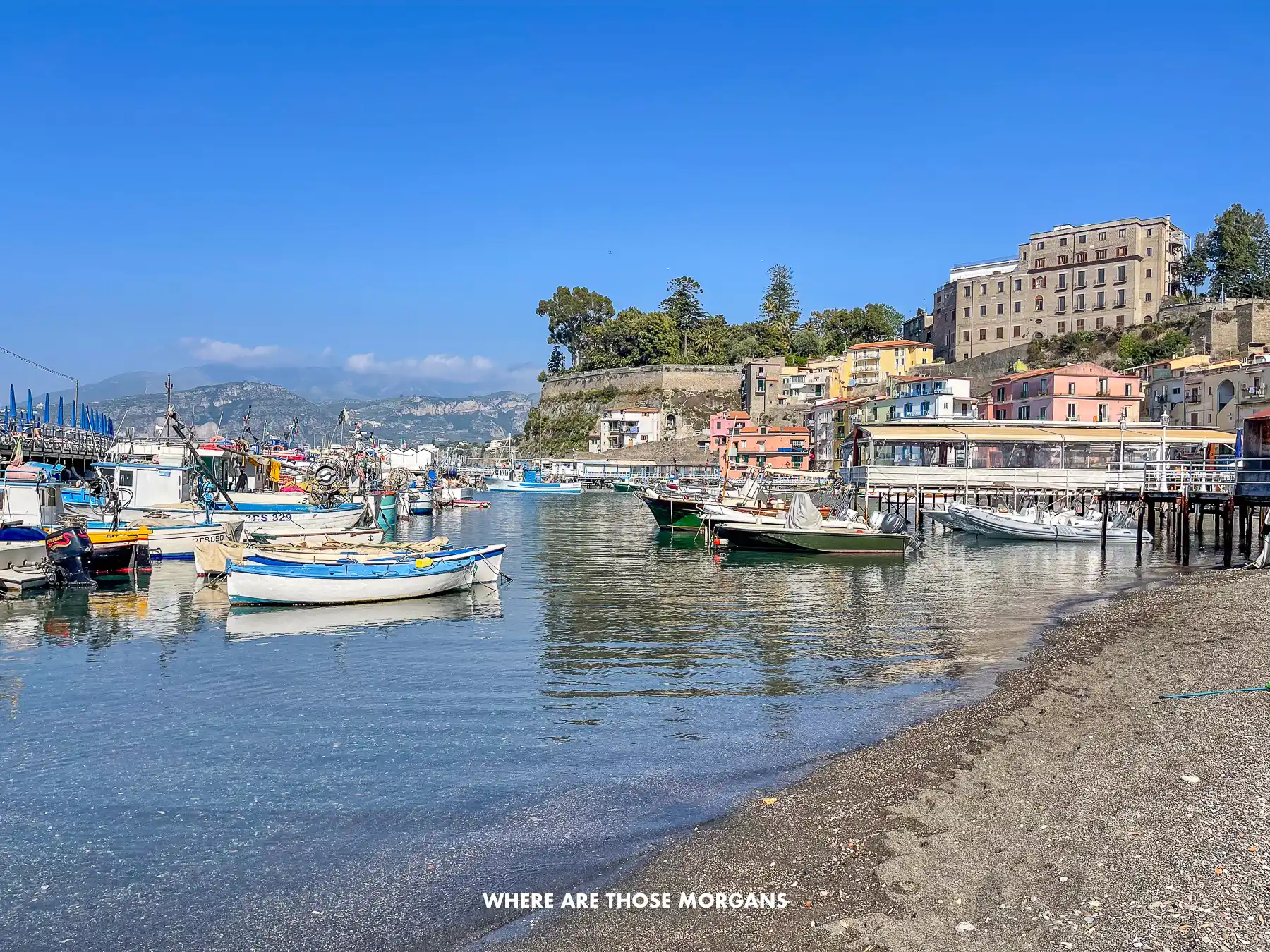 Spiaggia di Sorrento had clear water and more room to put a towel down
Spiaggia di Sorrento had clear water and more room to put a towel down
This public beach was bigger, quieter and free to use, plus the water was clear and further from the port. So we spent an hour relaxing on the beach before grabbing a snack and drink at Soul & Fish.
But the most important part of our visit to Marina Grande wasn’t sitting on the beach, it was discovering that the area was secluded and super attractive, so we decided to go back in the evening.
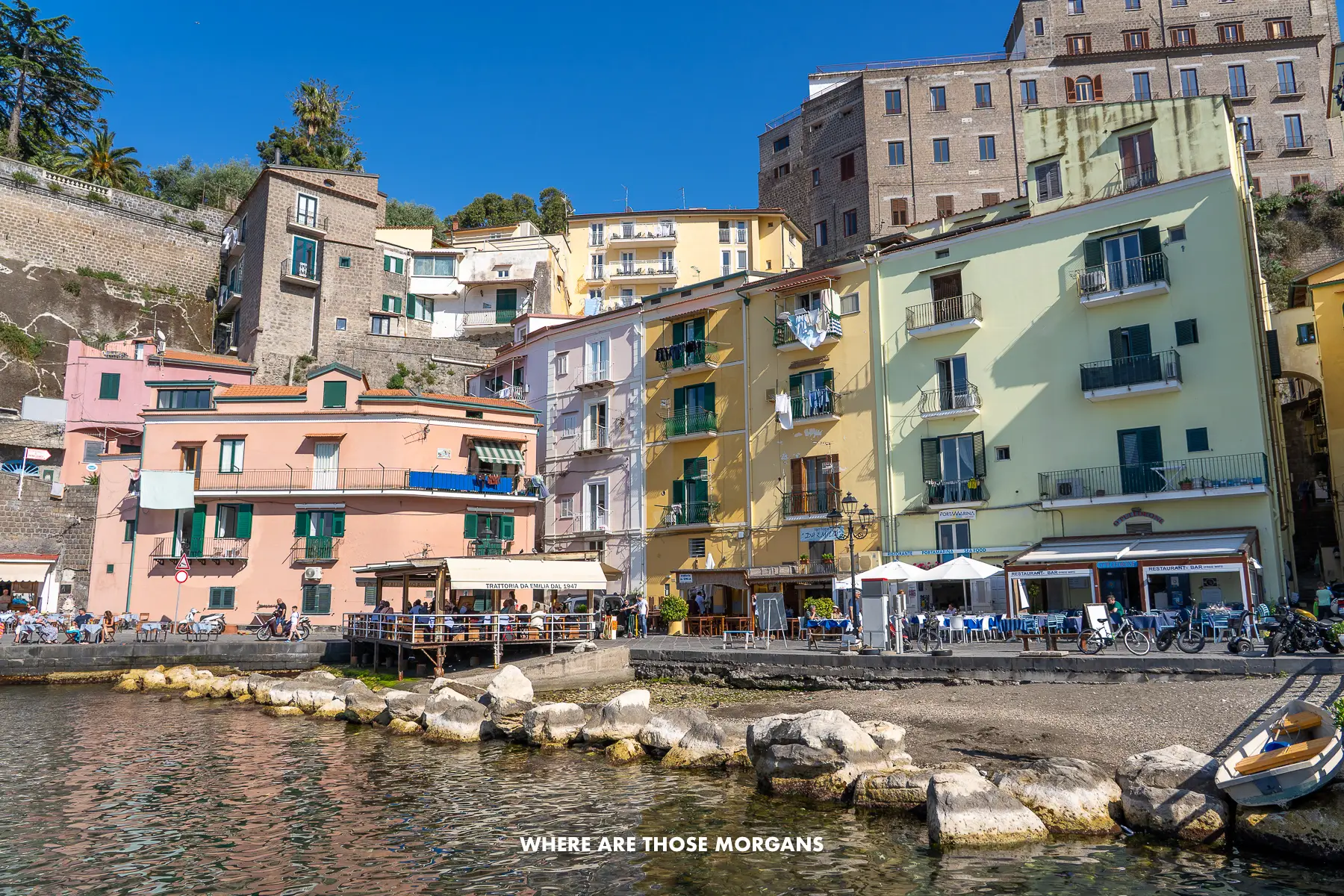 Marina Grande was a lovely place to enjoy a drink in the evening
Marina Grande was a lovely place to enjoy a drink in the evening
Later that day around 2 hours before sunset we walked back down into Marina Grande and sat outside Nonna Emilia right on the waters edge and topped up our Aperol Spritz intake.
It was busy so there was a buzzy atmosphere and the view over colorful buildings and dramatic cliffs was fantastic.
Hiking To Bagni Regina Giovanna
One of our top recommendations for unique Sorrento experiences is to hike 3km (1.9 miles) from town to Bagni Regina Giovanna and the Capo di Sorrento.
It’s a total of 6km (3.8 miles) roundtrip, and it took us around 45 minutes to walk in each direction. Here’s the directions to follow from Piazza Tasso.
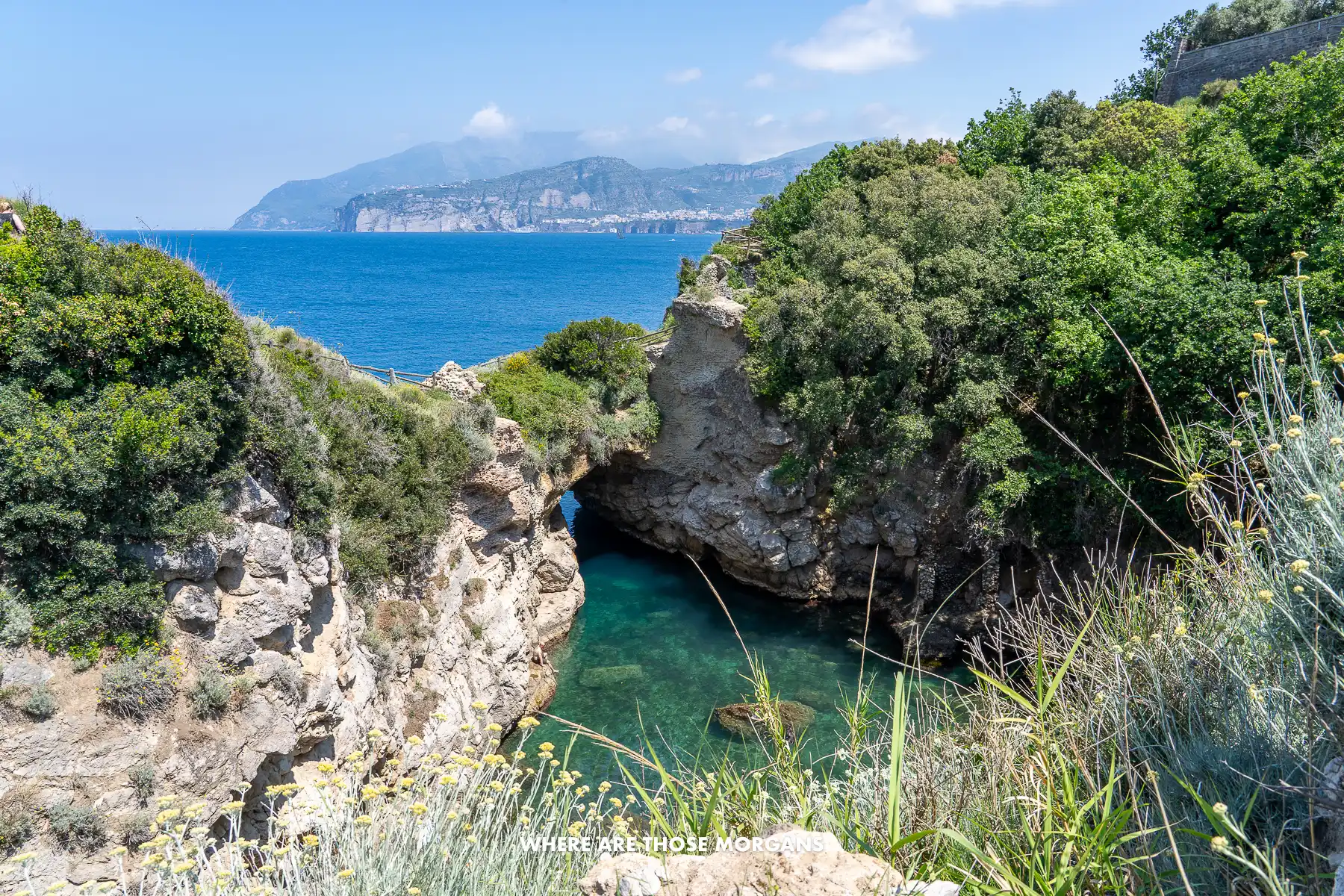 This was the top of the hidden swimming cove at Bagni Regina Giovanna
This was the top of the hidden swimming cove at Bagni Regina Giovanna
We love hiking so this was top of our list and it turned out be even better than expected. We arrived to find ruins of a Roman villa, stunning coastal views and a secluded beach inside a swimming hole with an arch leading out to sea.
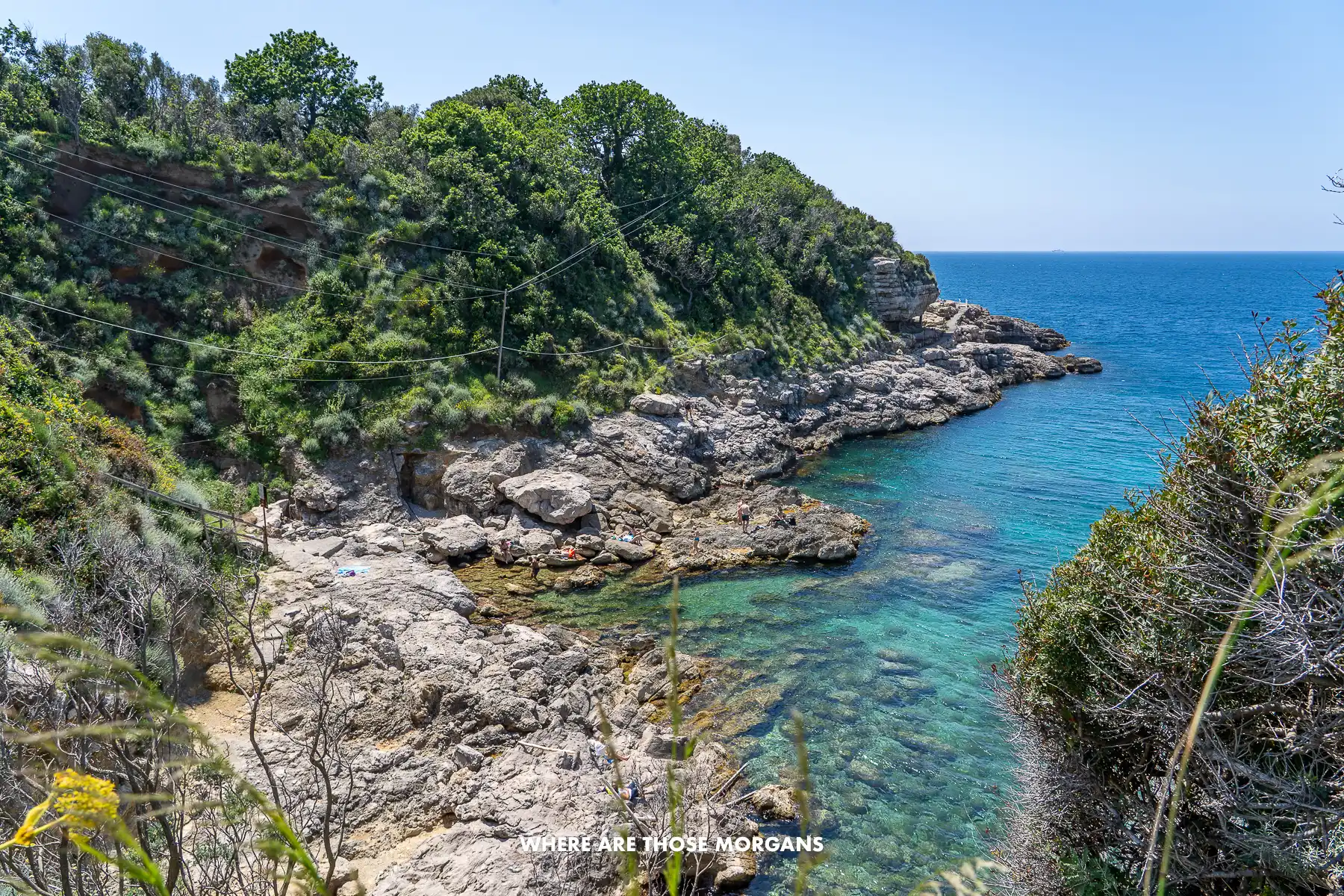 There were a few groups sunbathing but there was plenty of room
There were a few groups sunbathing but there was plenty of room
It wasn’t busy and there was plenty of room to fan out, so we found a few different spots to relax along different parts of the headland. We also spent some time exploring the ruins of the old villa, but it was pretty hairy in places so take care with footing if you do the same.
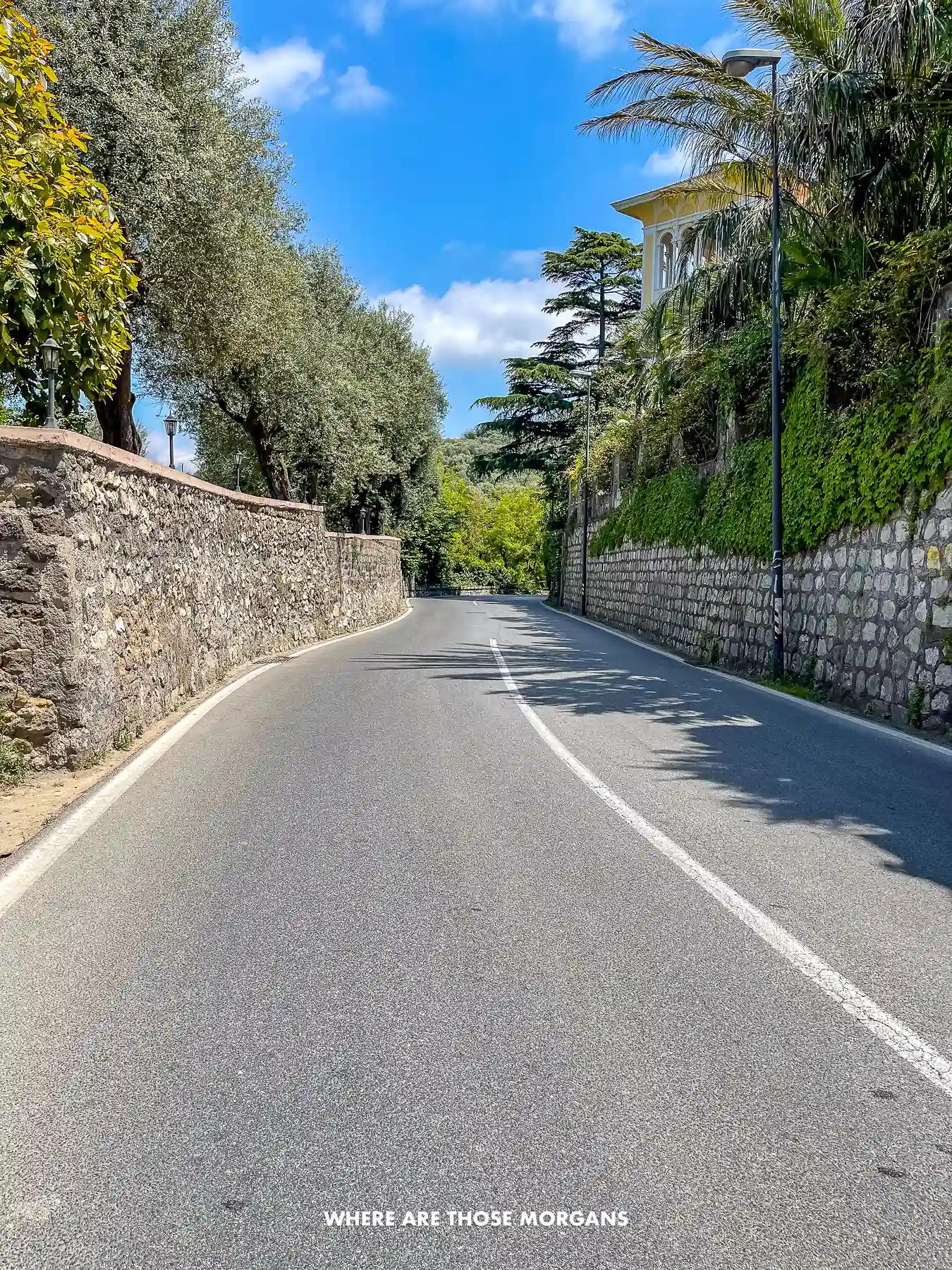 We walked along this stretch of road with no paths/sidewalks to reach the headland
We walked along this stretch of road with no paths/sidewalks to reach the headland
The first part of the walk from town was a gradual incline and opened up amazing views looking back over Sorrento. But shortly after we walked along a section of road without paths/sidewalks which we didn’t love, until it eventually led away from the road and to the headland.
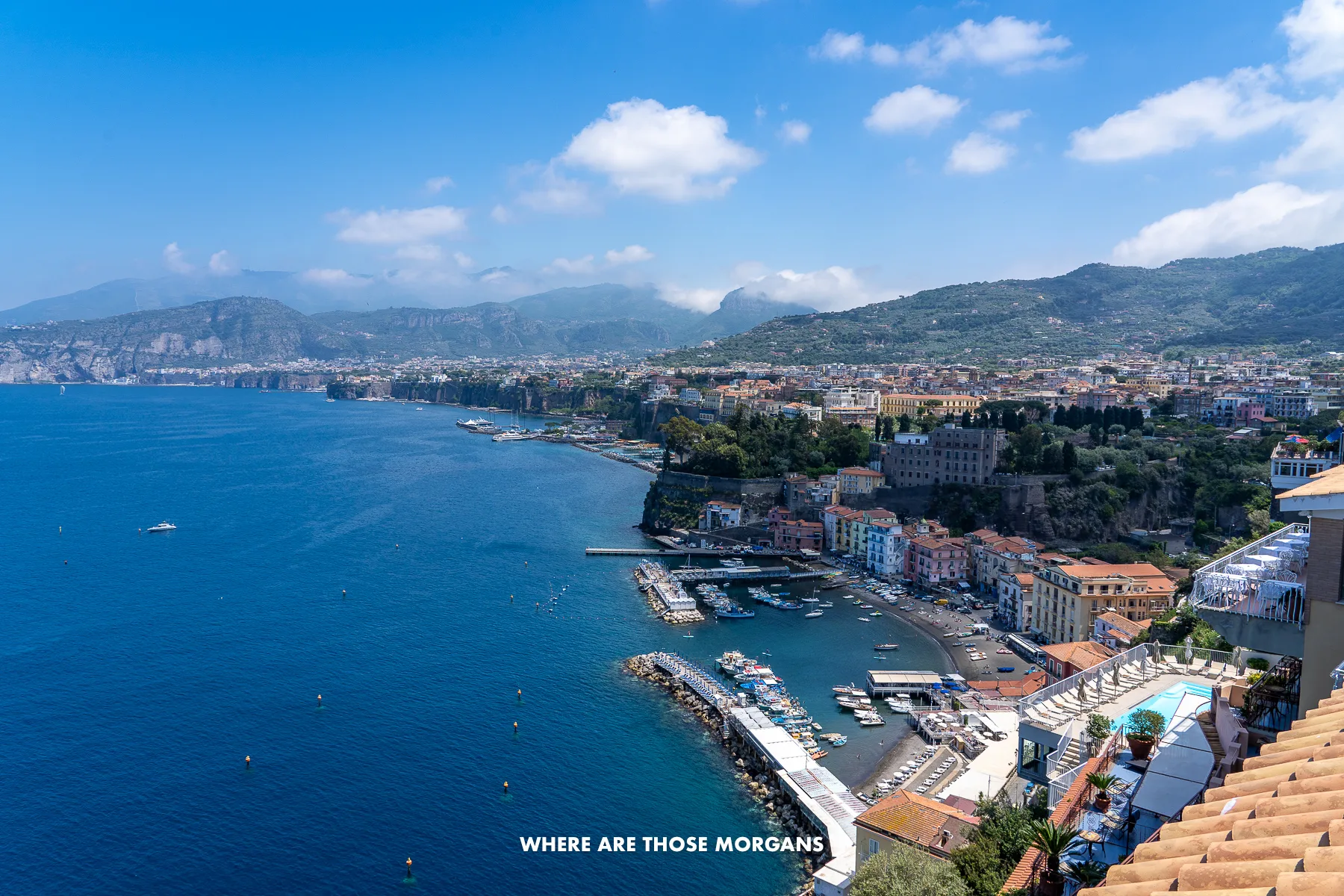 Walking out of town to the headland gave us this awesome view over Sorrento and the coastline
Walking out of town to the headland gave us this awesome view over Sorrento and the coastline
Don’t let the walk put you off, dozens of people do this every day so the locals are used to tourists walking on the roadsides. And it is a really cool spot at the end.
Tip: Don’t want to walk? Take a look at this top rated kayaking tour from Marina Grande to Bagni Regina Giovanna. It’s affordable and looks like fun!
Exploring Landmarks + Museums In The Historic Center
Instead of creating long individual sections for each landmark and museum in Sorrento, we’ll show you the ones we think are worth visiting all grouped together for the sake of keeping the guide concise.
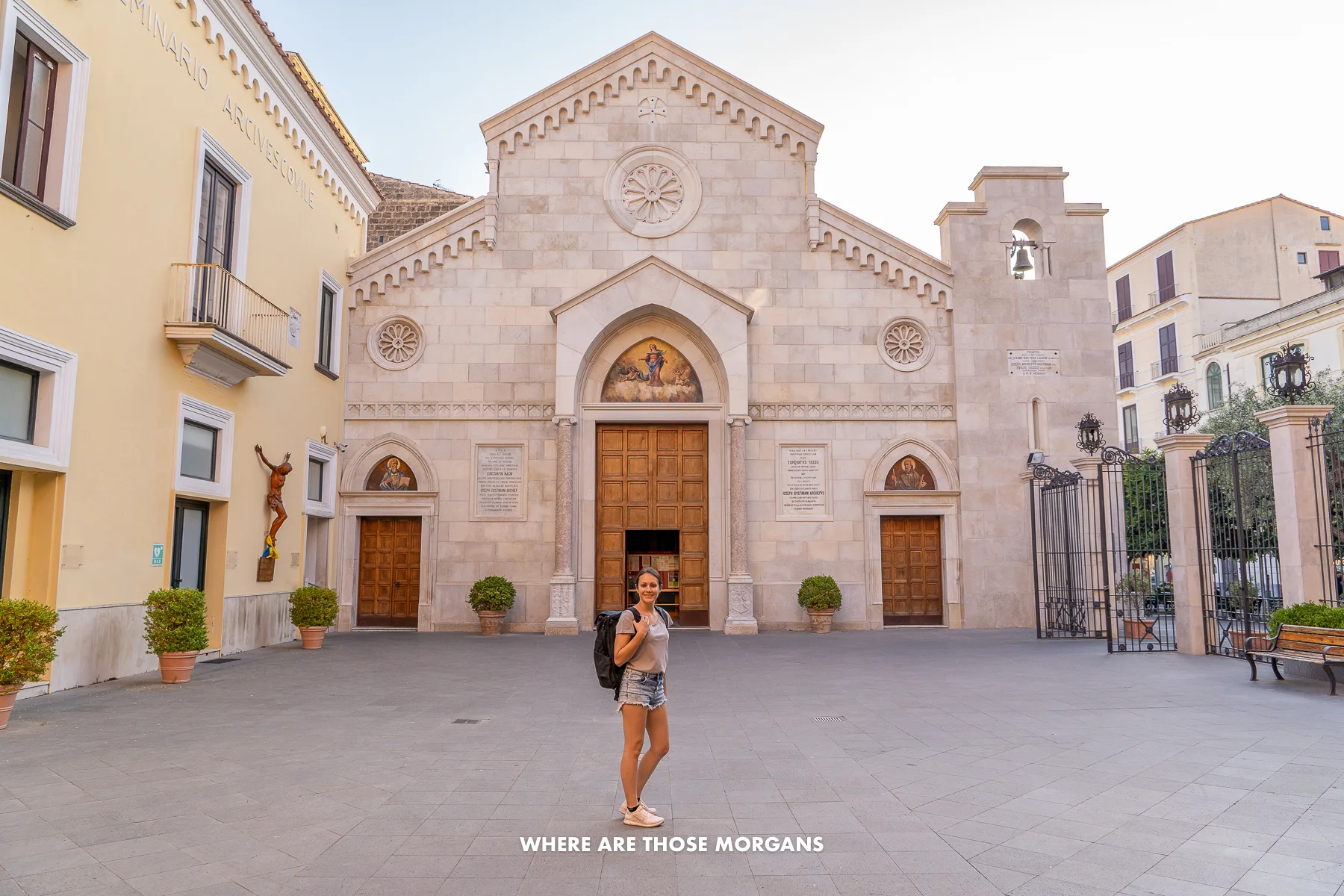 Here’s Kristen at Sorrento Cathedral along Corso Italia
Here’s Kristen at Sorrento Cathedral along Corso Italia
Sorrento Cathedral: The Cathedral of Saints Philip and James is the most important church in town, and we found it stunning from both the outside and inside. It was free to enter, there were no crowds, the frescoes were beautiful and it had a unique bell tower separate to the main cathedral.
Basilica di Sant’Antonino: It didn’t look like much from the outside but inside the 11th century church we found stunning architecture, columns, art work and detailed ceiling frescoes.
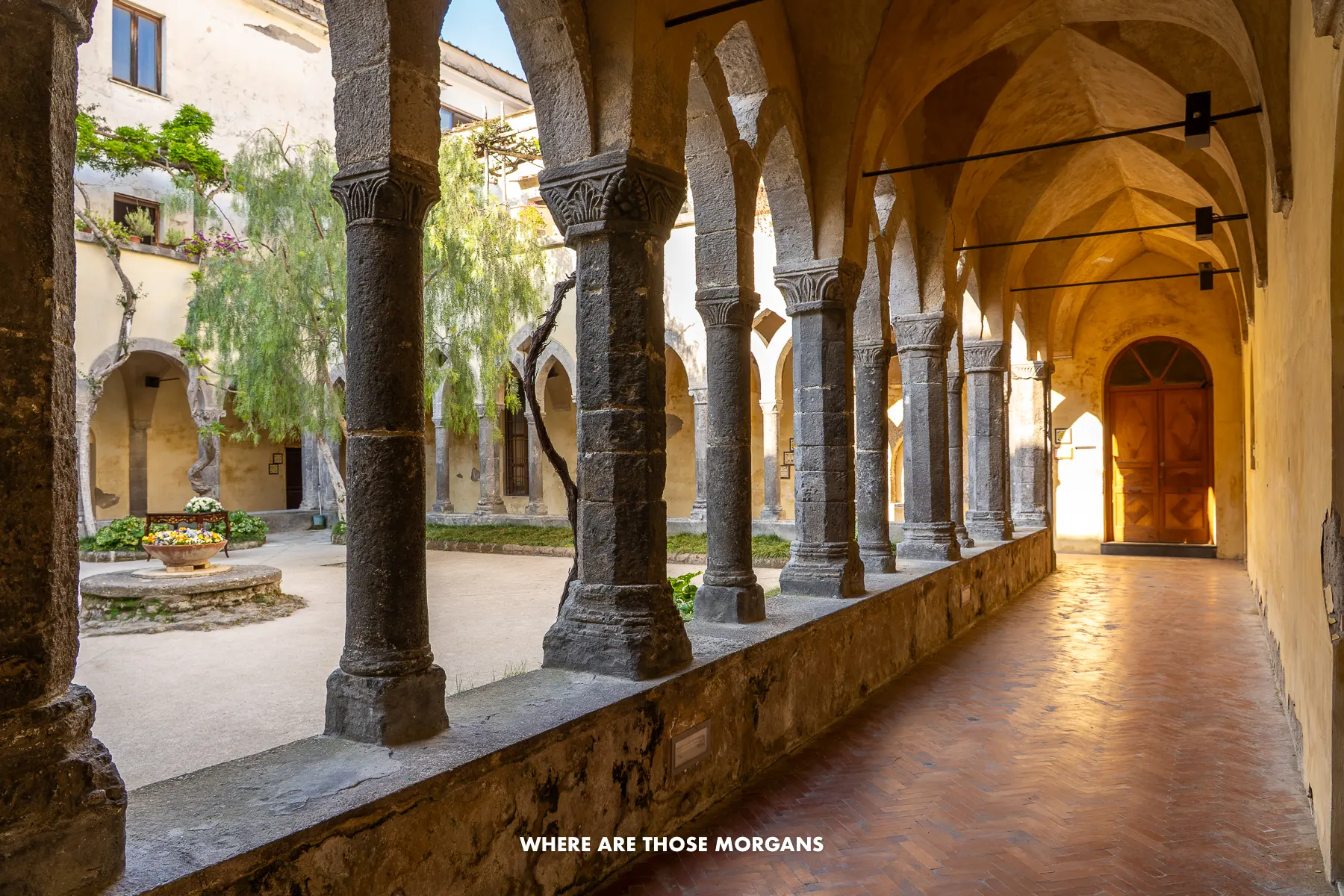 We loved the surprisingly photogenic monastery courtyard
We loved the surprisingly photogenic monastery courtyard
Chiostro di San Francesco: We actually stumbled into this 14th century monastery by mistake and it turned out to be the most photogenic place we visited in Sorrento. It was a lovely, charming and peaceful place to spend 10 minutes – and it made for excellent photos.
Bastione di Parsano: Parts of the Parsano Bastion date back to the 4th century BC when the Greeks and Romans occupied the region. The Spanish enhanced the walls in the 16th century as a form of protection against Saracen pirates, and today you can see a small portion of what remains. It was closed when we tried to visit so check opening hours before arriving.
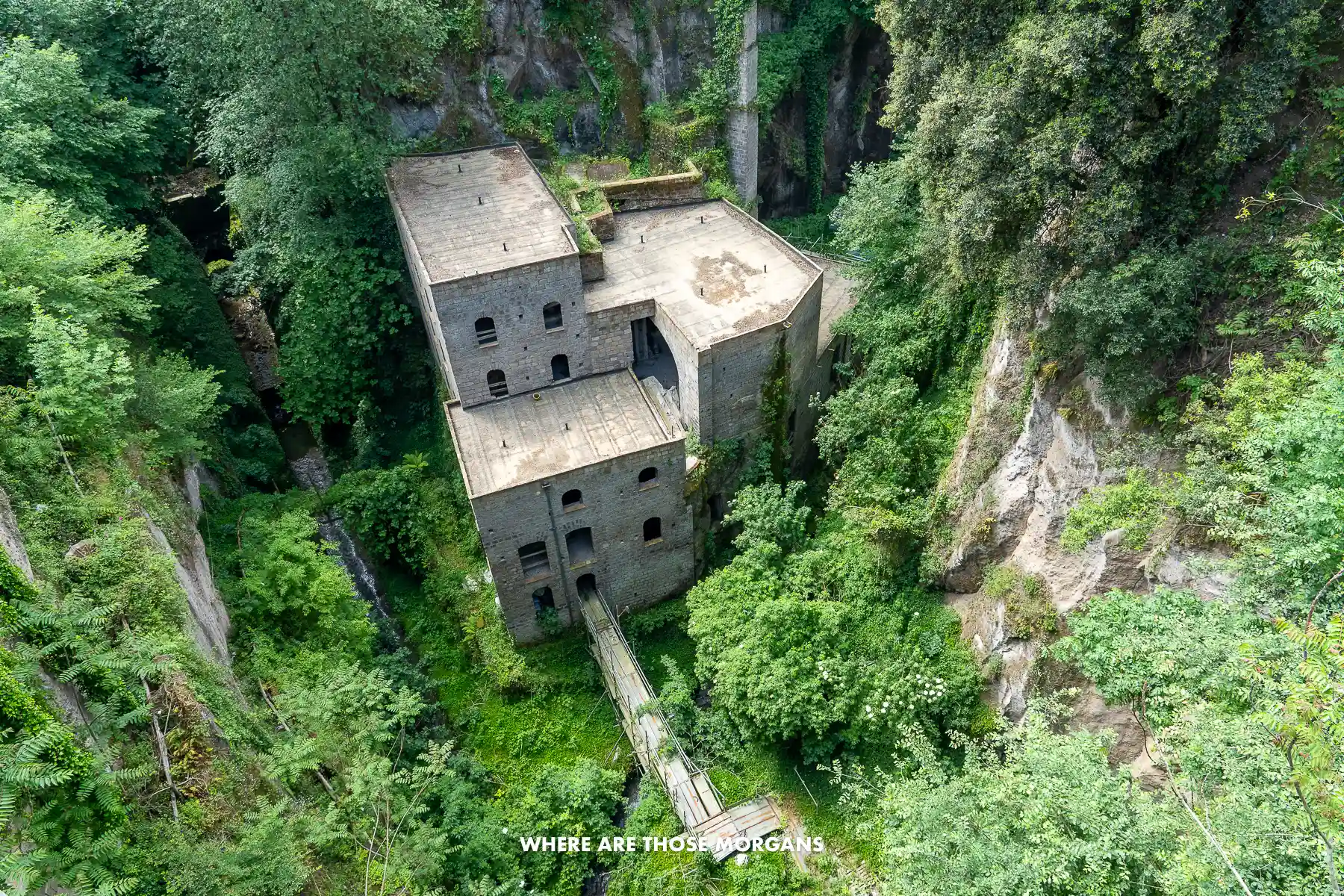 It was worth walking a few minutes to see this old wheat mill in a deep gorge
It was worth walking a few minutes to see this old wheat mill in a deep gorge
Vallone dei Mulini: We walked a few minutes south on Viale Enrico Caruso from Piazza Tasso to see a great big gorge and an old disused wheat milling building covered in vegetation at the bottom. It was an odd thing to see, but it made for a good photo so it was worth the quick walk.
Parco di Villa Fiorentino: When walking along Corso Italia we couldn’t help but be intrigued by the majestic white Villa Fiorentina, and right behind it is a small park that’s free to enter. If we had our books with us, this is where we’d be reading.
Visiting Museums
Do you enjoy visiting museums when you visit new places? Sorrento has three pretty obscure and unique options – the Museum of Inlaid Wood, the Correale Museum and the Sorrento Experience Museum.
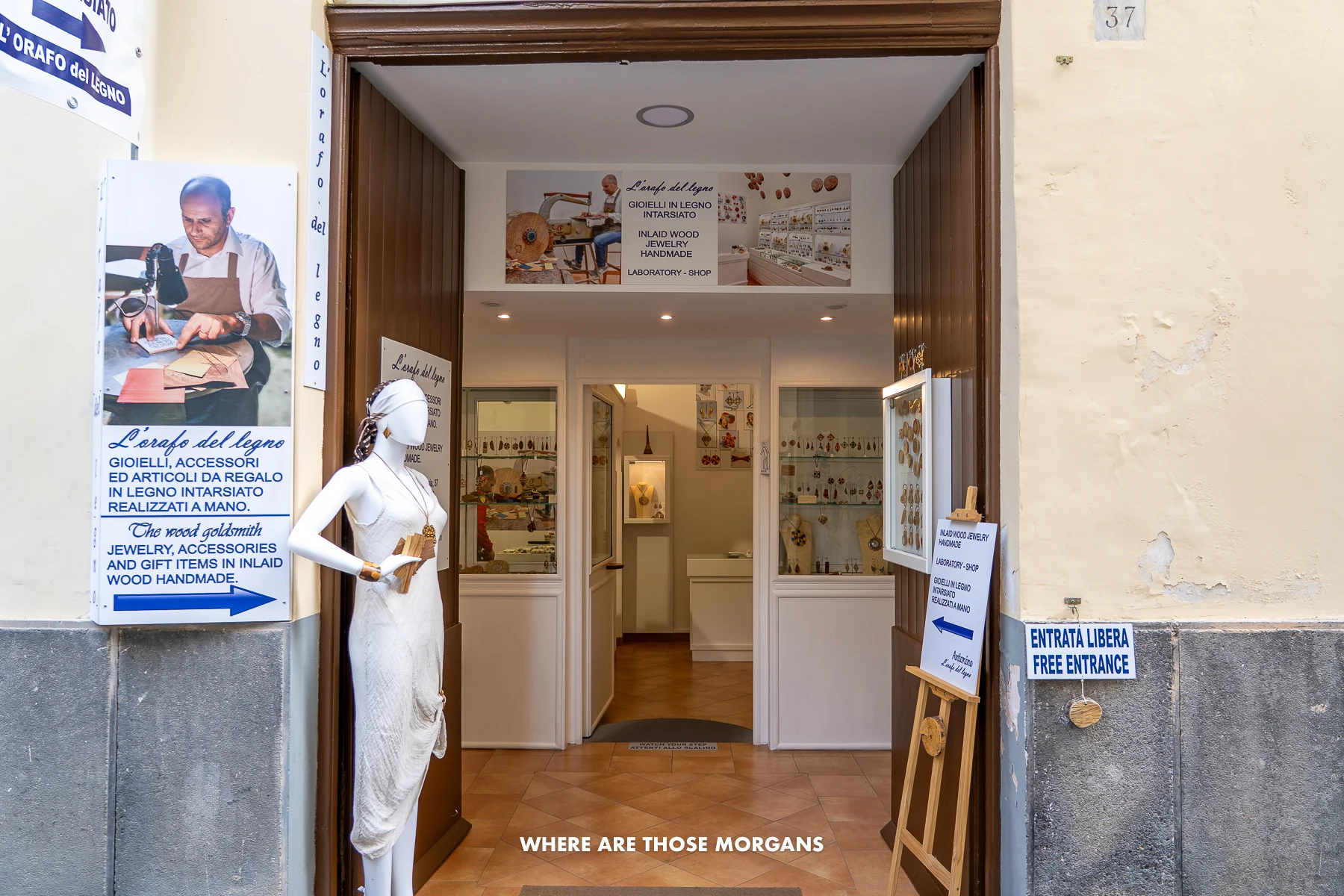 We went inside the inlaid wood gift store for a quick look at the handmade goods
We went inside the inlaid wood gift store for a quick look at the handmade goods
Museo Bottega della Tarsia Lignea: Sorrento’s inlaid wood museum would be a great little place to visit if you’re interested in woodwork, crafts or antiques. It costs €10 and has great reviews online.
Museo Correale di Terranova: This 18th century villa houses a collection of art works, paintings and furniture in 24 different rooms. It has a citrus grove and terrace with views over the Gulf of Naples. It costs €15 to go inside.
Sorrento Experience Museum: See the history of Sorrento from the 1st century until today in this multimedia museum with excellent reviews. It costs €11 for entry.
We love museums and usually go out of our way to visit as many as we can, but we were seriously short on time in Sorrento so we didn’t make it to any of the three in town unfortunately.
Tip: If you want to visit all three museums, buy this local museums pass that gives you a discount for bundling.
Watching Sunset At Villa Comunale
The view out to sea from Sorrento is northwest to northeast as you look at a map. That means in the summer when sunsets are more to the northwest (versus being more to the southwest in winter) you can see the sun setting against the distant horizon.
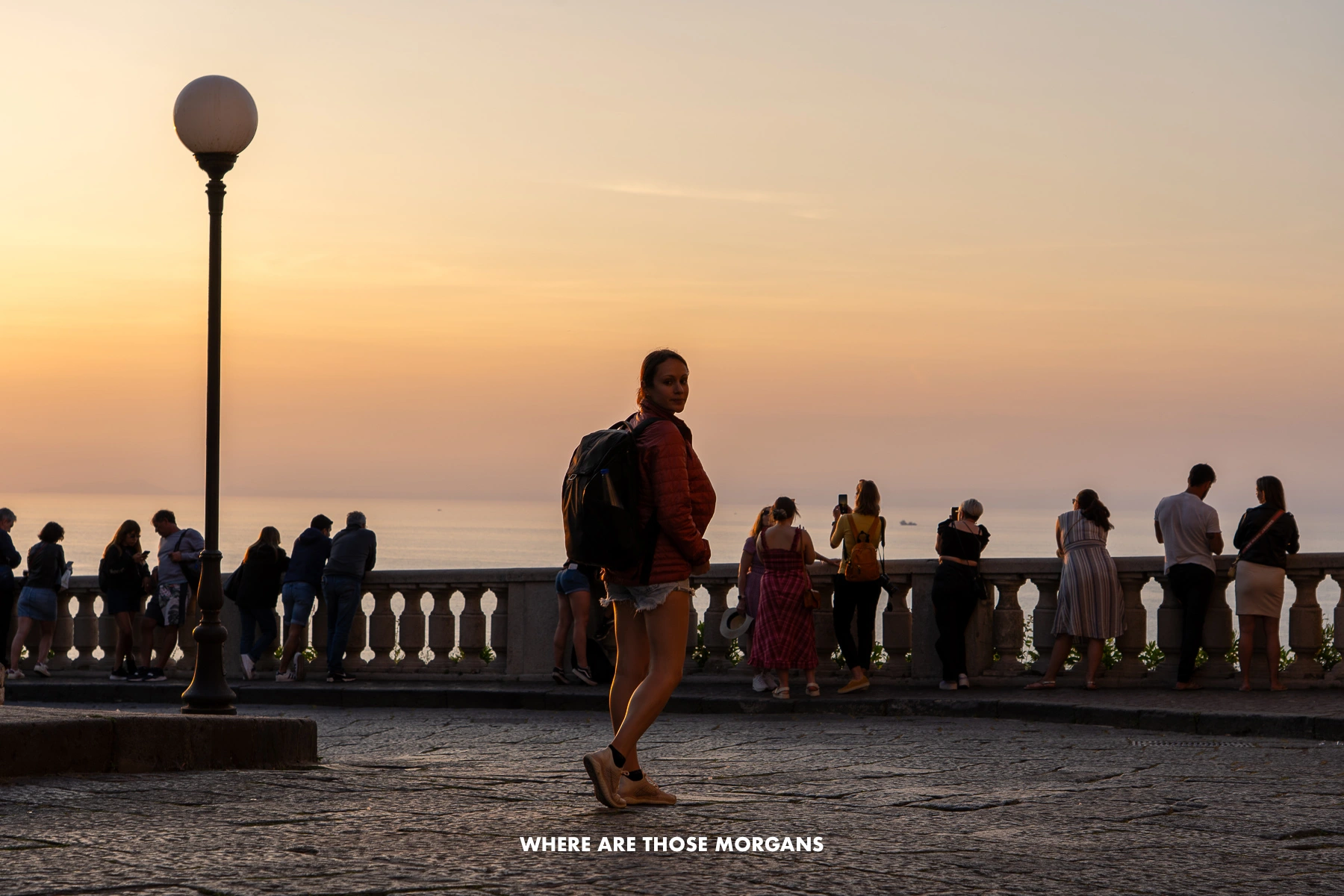 This was Kristen walking up to the sunset viewing area in Villa Comunale
This was Kristen walking up to the sunset viewing area in Villa Comunale
We love sunrises and sunsets so we did our research and it was clear that Villa Comunale – which is a public park at the top of the cliffs – was the most popular place to watch the sunset.
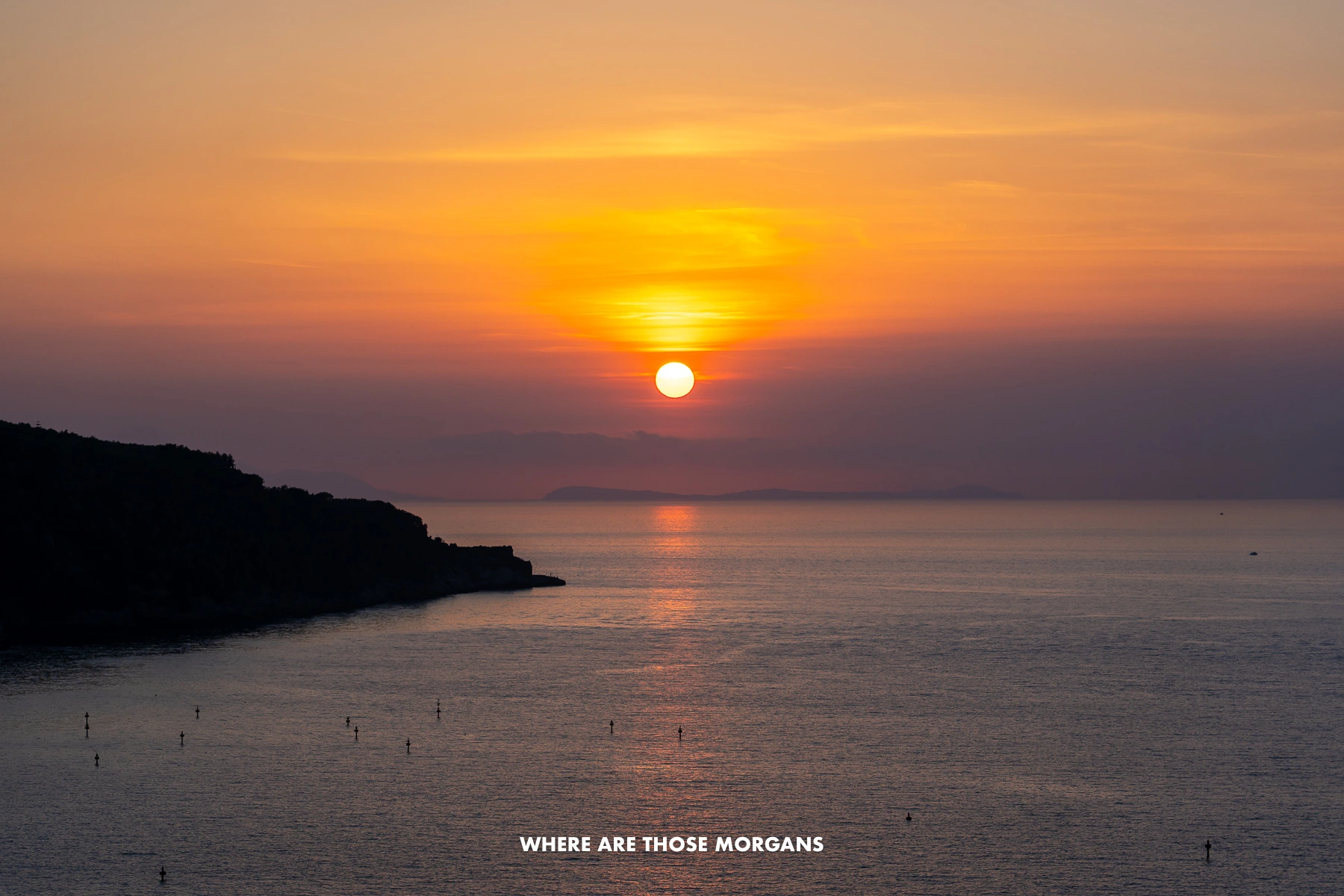 We were lucky to get a serene sunset with vibrant colors in the sky
We were lucky to get a serene sunset with vibrant colors in the sky
So after leaving Marina Grande we walked for 15 minutes and arrived at Villa Comunale in time to enjoy a serene and colorful sunset.
It was busy with tourists, but it had a lovely atmosphere and even in May we were just about able to see the sun as it set on the distant northwest horizon.
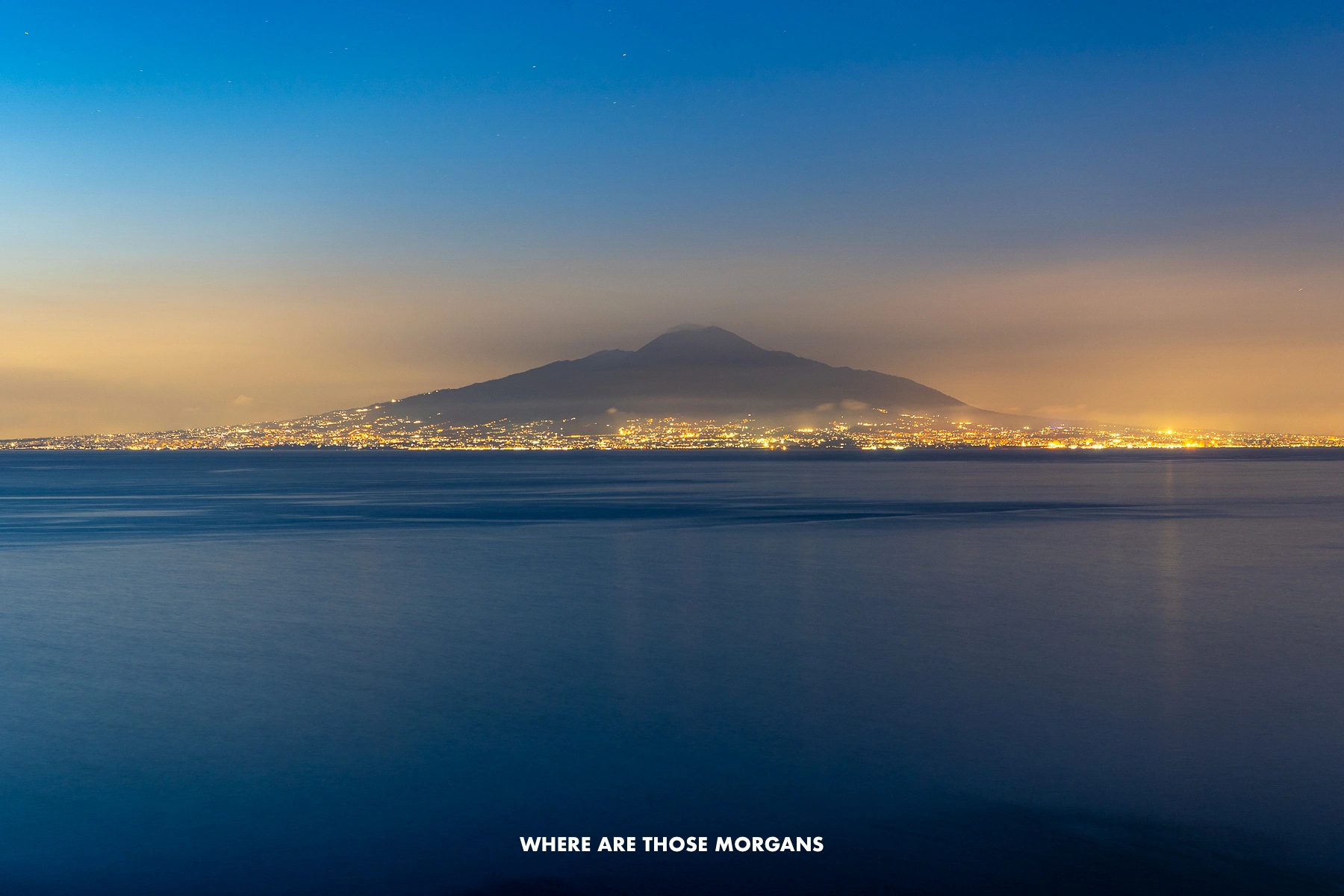 We stayed until well after sunset to capture this photo of Mount Vesuvius
We stayed until well after sunset to capture this photo of Mount Vesuvius
We knew there would be a great photo of Mount Vesuvius if we waited around at Villa Comunale after the sun had set. So we grabbed an Aperol Spritz at La Villa right there at the viewing area, which was overpriced but it had a lively buzz so we were happy to pay extra.
And we’re so glad we waited. The 30 second exposure we captured of Mt Vesuvius eerily looming over the towns on its foothills across the bay is one of our favorite photos from the Amalfi Coast.
Taking Day Trips
Obviously if you’re short on time you won’t be taking a day trip, but if you’ll be visiting Sorrento for 3+ days we highly recommend considering at least one day trip because there’s so many fantastic places right on the doorstep.
Based on all the things we’ve done around the Gulf of Naples and Amalfi Coast, we would tell our friends and families that Capri, Positano and Pompeii are the best day trips from Sorrento.
We also enjoyed Herculaneum, Vesuvius, Amalfi, Ravello and Naples, but they’re not as easy to get to so if it’s your first time in the area you should prioritize those first three spots.
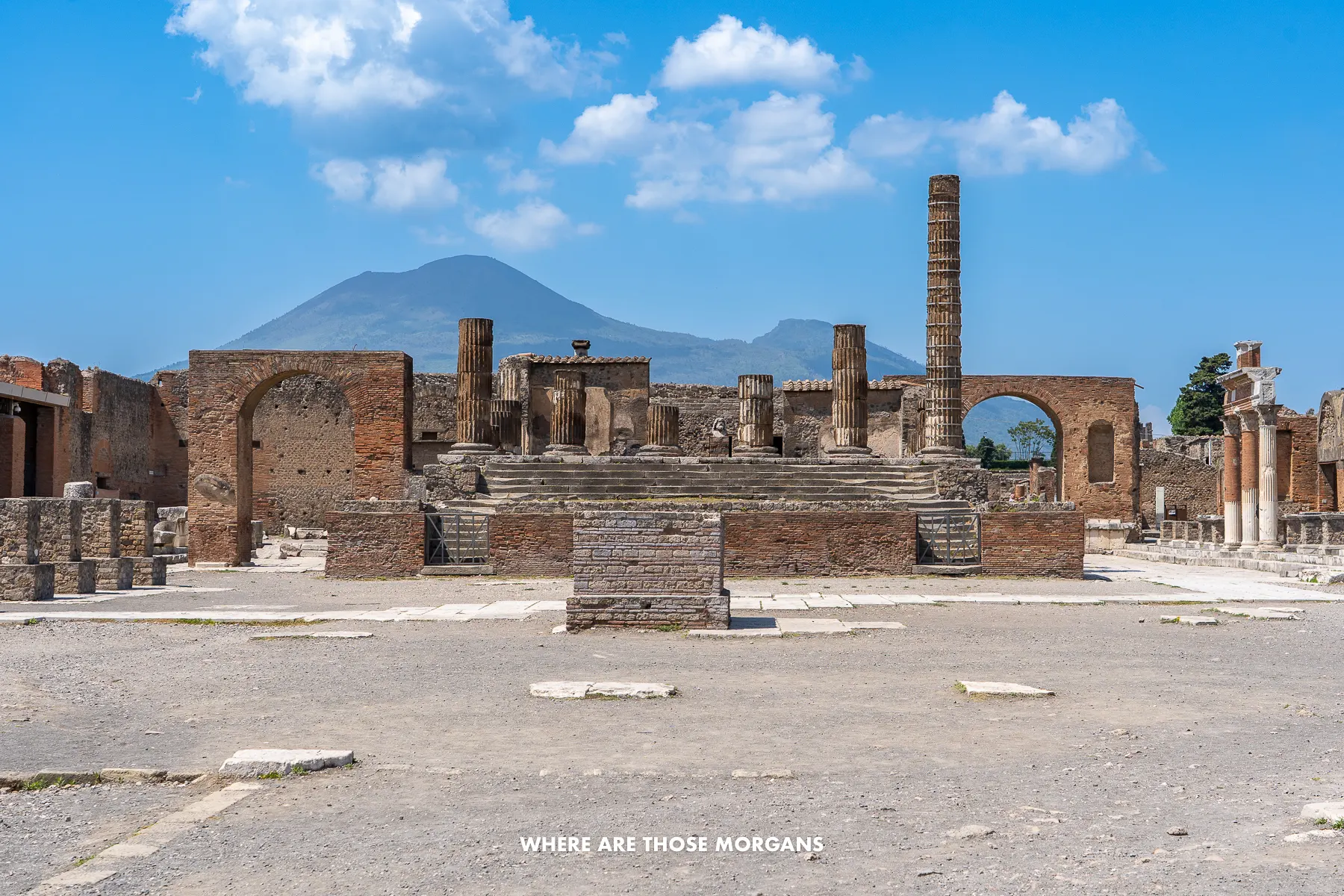 We waited an age to get this photo of Pompeii and Vesuvius with no people
We waited an age to get this photo of Pompeii and Vesuvius with no people
Doing It Yourself
Pompeii is easy and cheap to do from Sorrento, just buy your tickets in advance and take the blue train line to Pompei Scavi. Don’t risk waiting in line to get your tickets because they sell out each day. We’ve been to Pompeii twice and it really is a unique experience.
Vesuvius is harder from Sorrento because the logistics don’t work as well, and buying tickets online is confusing. We took the Vesuvius Express from Ercolano (Herculaneum) which included roundtrip bus and entry tickets to the crater, so take the same blue train line from Sorrento to Ercolano – and this way you can also visit the Herculaneum ruins.
Capri is easy to reach from Sorrento by this ferry line. Once you arrive into port, take the funicular up to town and visit the Gardens of Augustus. We took this same ferry after leaving Sorrento, but we stayed in Capri for three days. What an amazing island!
Alternatively, you can take a bus or ferry to Positano, which we think is the most ritzy and photogenic town along the Amalfi Coast proper. There’s not a huge amount to do once you get to Positano but it’s a seriously picturesque cliffside town.
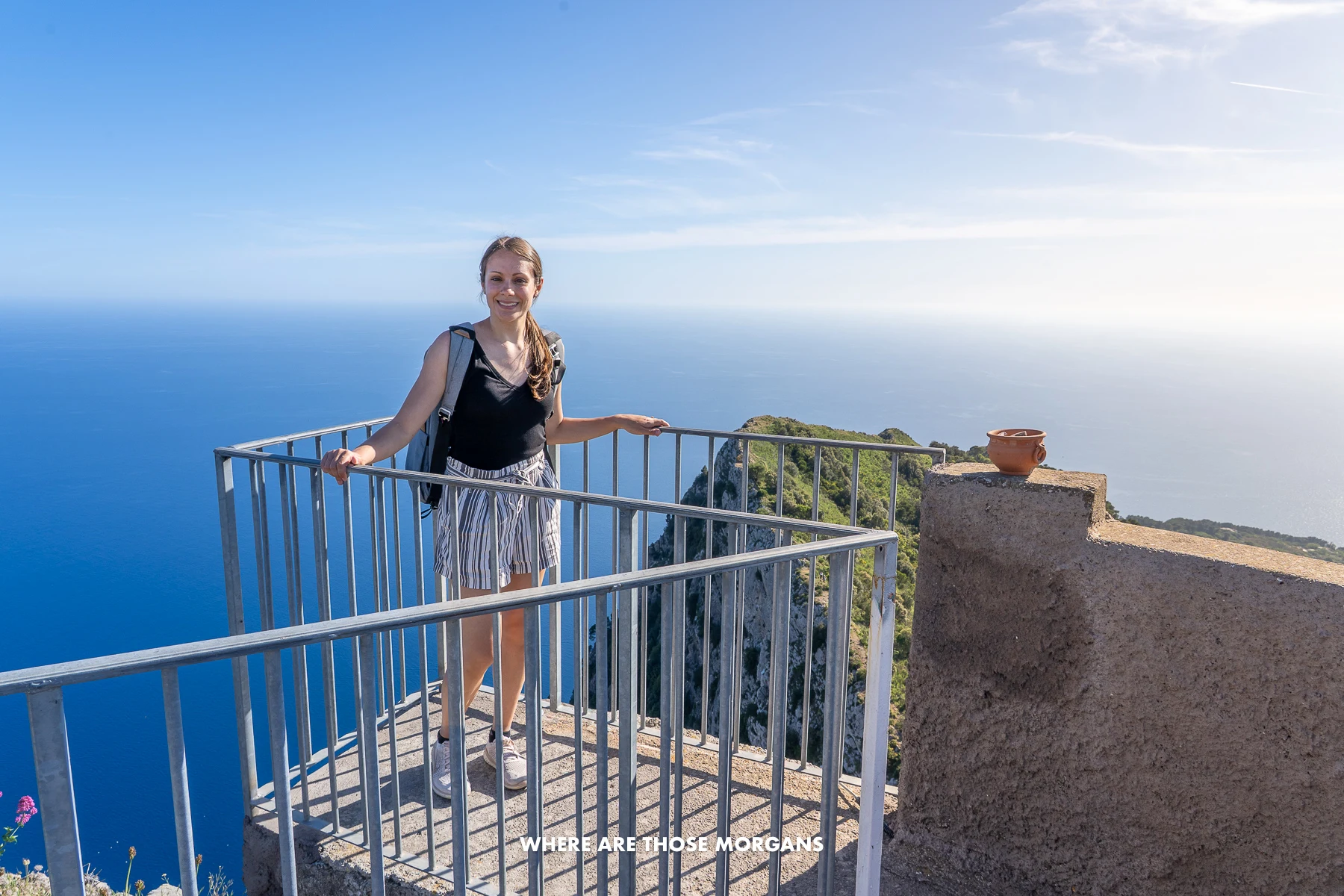 Here’s Kristen at the top of Monte Solaro in Capri
Here’s Kristen at the top of Monte Solaro in Capri
Booking A Guided Tour
Would you rather have someone else do the organizing, driving and explaining? Guided tours not only save time and effort, but they also give you a local guide who can answer questions and explain what you’re looking at.
Here are the tours with the highest ratings that we’d actually do ourselves:
Pompeii – If you’re happy to get the train and just want a professional guided tour that you can trust will give you the best possible Pompeii experience, book this top rated tour with Walks of Italy. We’ve done tours with them and they’re an excellent company. Alternatively, if you’re visiting in a small group of 4-6 people, you might want to book this private tour with Walks of Italy for a more intimate experience.
Vesuvius – If you want to combine Pompeii and Vesuvius from Sorrento but don’t want to deal with the train to Ercolano and another bus, take a look at this guided tour with Viator that includes roundtrip transport to Vesuvius from Pompeii along with entry tickets to both sites.
Capri – You have two options here. Either take this guided tour of the major attractions on Capri or take this boat tour which sails around the island, stopping at famous landmarks with a few hours to see the town. Both include roundtrip transport from Sorrento.
Amalfi Coast – This top rated boat tour from Sorrento stops at both Amalfi and Positano, or this popular bus tour stops at Positano, Amalfi and Ravello so it ticks off the three major stops on the Amalfi Coast.
Sorrento Attractions Map
How to use this map: Click the map above to activate, then tap any icon to see more information. See a list of all attractions by clicking the arrow icon in the top left, or see a full version of the map by clicking the “view larger map” icon in the top right.
How to save this map: Click the small star next to the map title – this will add the map to your Google account. Open your Google Maps app, tap “saved”, then tap “maps” and open this map.
Next Steps
We hope our guide on the top things to do in Sorrento helps with planning your trip, but please let us know if you have any other questions in the comments box a little further below.
Still figuring out your plans for Italy?
Finally, if you’ll be visiting more places on the same trip, we recommend reading our Italy travel guide for helpful tips and advice.
Happy Travels,
Mark and Kristen
Find our guide helpful? Pin it for later!
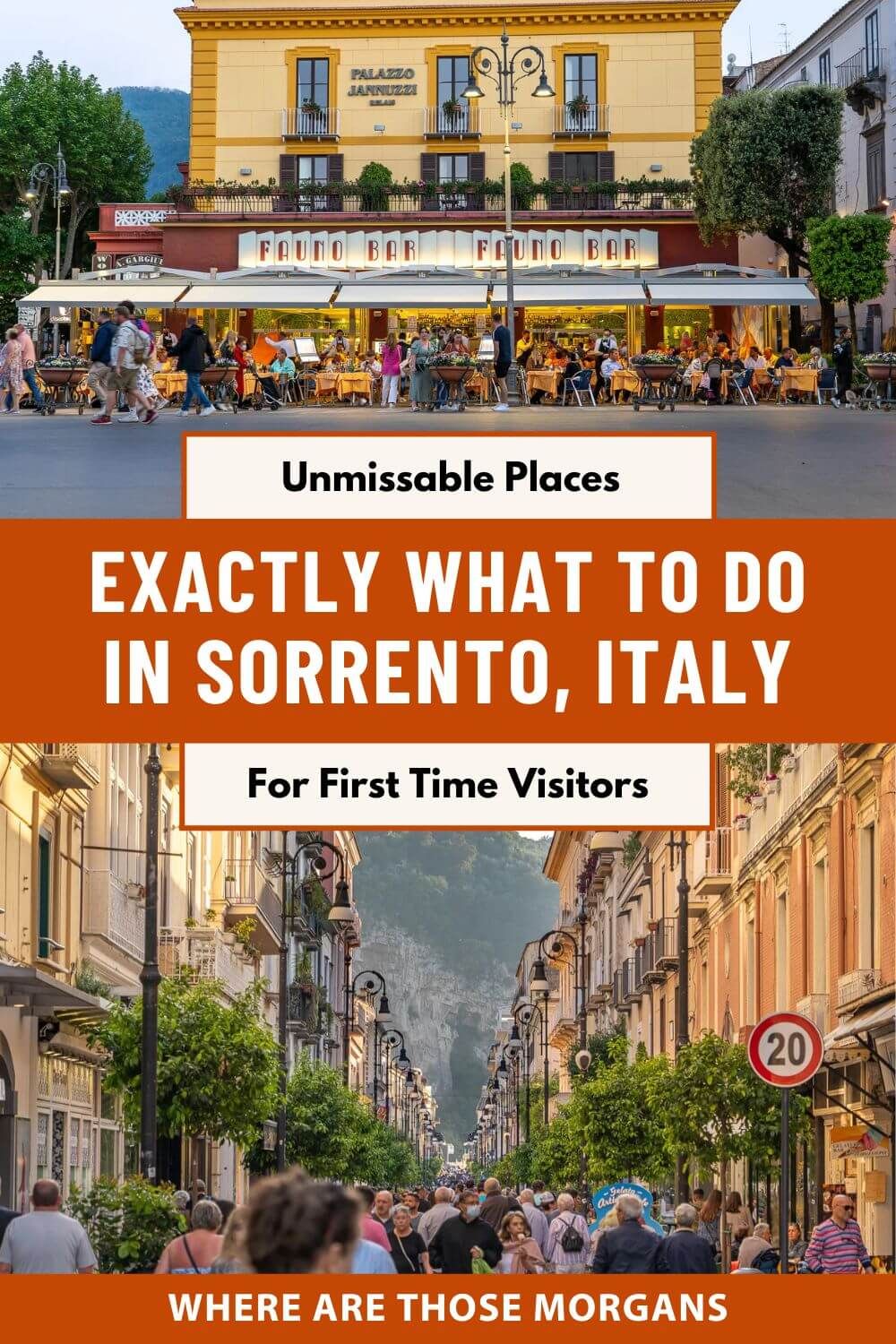

All Rights Reserved © Where Are Those Morgans, LLC. Republishing this article and/or any of its contents (text, photography, maps, graphics, etc.) in whole or in part is strictly prohibited.

Mark and Kristen spent 6 years traveling the world, visiting over 40 countries across 4 continents and more than 30 US states. They created Where Are Those Morgans in 2018 to help others plan the best possible vacations by writing authentic travel and hiking guides based on their real experiences.
Since the arrival of baby Maya in late 2024, Mark and Kristen’s extensive travels have slowed down but they still take plenty of trips. Where Are Those Morgans now helps millions of travelers each year to visit new places and hike new trails through information-packed blog posts and expert travel guidebooks. Read more about Mark and Kristen.
